
Writing/Film
Dear Aspiring Writers: The Worst Advice You'll
Ever Read
A Literary Look at
I-State Lines
Spirited Away: Decay and Renewal
An American Poem
(Robinson Jeffers)
Taoist Chinese Poems
The Nelson Touch
"It's all about oil, isn't it?"
Kurosawa's High and Low
A Bountiful Mutiny
Howl's Moving Castle
Thailand's Iron Ladies
Trois Colours: Red
The Thin Man: Thoroughly Modern Movies
Why My Book Is Better Than the DaVinci Code
Iranian Films: The Mirror
Piratical Nonsense
A Real Pirate Movie: Captain Blood
9 more in archive
Recommended Books
American Identity
Hapas: The New America
Can You Tell What I am? Part I
Can You Tell What I am? Part II
Only in America
Self-Reliance
Your Tattoo in 50 Years
The American House and Frank Lloyd Wright
Cultural Commentaries
On Hatred and Anti-Americanism
Anti-Americanism
Part 2
Anti-Americanism
Part 3
French-Bashing
Germany: We All Have Problems, But...
Kroika! Chronicles
This Blog Sells Out
Doom and Gloom Sells
The Kroika Mascot-"Auspicious Pet"
Wal-Mart and Kroika
Kroika and Starsbuck Take a Hit
Kroika Ad 1
Kroika Ad 2
Kroika Ad 3
Kroika Ad 4
Kroika Makes Bid for Oreo (April 1)
Unfolding Crises: Asia
China: An Interim Report
Shanghai Postcard 2004
Corruption and Avian Flu: China's Dynamic Duo
Exporting the Real Estate Bubble to China
Is the Bloom Off the China Rose?
China Irony: Steel, Marx & Capital
Curing The U.S. and China's Dysfunctional Relationship
China and U.S. Inflation
Trade with China: Making Out Like a Bandit
Whither China?
Will the Housing Bust Take Down China?
China's Dependence on Exports to U.S.; Is China About to Pop?
8 more
Battle for the Soul
of America
Katrina, Vietnam, Iraq: National Purpose, National Sacrifice
Is This a Nation at War?
A Nation in Denial
Why Is This Such a Tepid Time?
That Price Isn't Cheap, It's Subsidized
The Most Hated Company in America
U.S. Fascists Seek Ban on Cancer Vaccine
The Truth About Christmas
American Dream or American Nightmare?
2006 Sea Change
Obesity and Debt
Immigration Ironies
U.S. Healthcare: Working Toward a Real Solution
A Drug Industry Running Amok
Where There Is Ruin
10 more
Financial Meltdown Watch
What This Country Needs Is a... Good Recession
Are We Entering the Next Age of Turmoil?
Why Inflation Appears Low
Doubling Down on 5-Card No-See-Um
A Rickety Global House of Cards
Are Japan and Germany Truly on the Mend?
Unprecedented Risk 2
Could One Rogue Trader Bring Down the Market?
Worried about Inflation? Stop Measuring It
Economy Great? Bah, Humbug
Huge Deficits and Huge Profits: Coincidence?
Who's The Largest Exporter?
Three Snapshots of the U.S. Economy
Loaded for Bear
Comparing Nasdaq to Depression-Era Dow
Who's Buying Treasury Bonds? And Why?
Derivatives: Wall Street Fiddles, Rome Smolders
Financial Chickens Coming Home to Roost
Is the Stock Market on the Same Planet as the Economy?
The Housing-Recession-Oil-Healthcare Connection
Could We Have Deflation and Inflation At the Same Time?
What We Know, What We Can Safely Predict
Bankruptcy U.S.A.: Medicare, Greed and Collapse
Sucker's Rally
A Whiff of Apocalypse
Where There Is Ruin II: Social Security
31 more
Planetary Meltdown Watch
The Immensity of Global Warming
Sun Sets on Skeptics of Global Warming
Housing Bubble Watch
Charting Unaffordability
A Monster of a Housing Bubble
A Coup de Grace to the Economy
Hidden Costs of the Housing Bubble
Housing Bubble? What Bubble?
Housing Bubble II
Housing Bubble III: Pop!
Housing Market Slips Toward Cliff
Housing Market Demographics
Housing: Catching the Falling Knife
Five Stages of the Housing Bubble
Derailing the Property Tax Gravy Train
Bubbling Property Taxes
Have You Checked Your Property Taxes Recently?
Housing Bubble: Where's the Bottom?
Housing Bubble: Bottom II
The Housing - Inflation Connection
The Coming Foreclosure Nightmare 1
How Many Foreclosures Will Hit the Market?
Housing Wealth Effect Shifts Into Reverse
Housing Bubble Bust Will Take Down the Global Economy
The New Road to Serfdom: A Negative-Equity Mortgage
The Housing-Savings-Recession Connection
After the Bubble: How Low Will It Go?
After the Bubble: Rents and Housing Values
Why Post-Bubble Rents Matter
After the Bubble: How Low Will We Go, Part II
Housing: 10% Decline May Trigger Financial Ruin
How to Buy a $450K Home for $750K
Inflation and Housing: Calculating the Bust
The Growing Financial Risks of the Housing Bubble
Construction Defects: The Flood to Come?
Construction Defects
Part II
Who Gets Hammered in the 2007 Housing Bust
Real Estate Bust: The Exhaustion of Debt
What Happens When Housing Employment Plummets?
One More Hole in the Housing Bubble: Insurance
Financial Kryptonite in a "Super-Strength" Housing Market
Three Secrets to Unloading Property Today
Welcome to Fantasyland: Housing's "Soft Landing"
Why Is the Median House Price Still Rising?
Why Median Prices Appear to be Rising?
The Root Cause of the Housing Bubble
Housing Dominoes Fall
Twilight for Exurbia?
Phase Transitions, Symmetry and Post-Bubble Declines
10 more
Oil/Energy Crises
Whither Oil?
How much Is a Gallon of Gas Worth?
The End of Cheap Oil
Natural Gas, Naturally High
Arab Oil Money and U.S. Treasuries: Quid Pro Quo?
The C.I.A., Oil and the Wisdom of Crowds
The Flutter of a Butterfly's Wings?
A One-Two Punch to a Glass Jaw
Running Out Of Oil vs. Running Out of Cheap Oil
2 more
Outside the Box
How to Make a Favicon
Asian Emoticons
In Memoriam: Winky Cosmos
The Wheeled Vagabonds
Geezer Rock Overload
Paying for Web Content
In a Humorous Vein
If Only Writers Had Uniforms
Opening the Kimono
Happiness for Sale: Jank Coffee
Ten Guaranteed Predictions for 2010
Why My Book Is Better Than the DaVinci Code
My Brand Management Stinks
Design Follies
The New Jank Coffee Shop
Jank Coffee, Upscale Tropic Style
One-Word Titles
Complacency
Nostalgia
Lifespans
Praxis
Keys to Affordable Housing
U.S. Conservation & China
Steve Toma, Me & Skil 77s: 30 years of Labor
Real Science in the Bolivian Forest
Deforestation and Sustainable Forestry
The Solar Economy (book)
The Problem with Techno-Fixes
I Love Technology, I Hate Technology
How To Blow off Web Ads and More
2 more
Health, Wealth & Demographics
Beauty of the Augmented (Korean) Kind
Demographics and War
The Healthiest Cold Cereal: Surprise!
900 Miles to the Gallon
Are Our Cities Making Us Fat?
One Serving of Deception
Is Obesity an Inflammatory Response?
Demographics & National Bankruptcy
The Decline of Europe: A Demographic Done Deal?
Are the Risks of Obesity Overstated?
Healthcare: Unaffordable Everywhere
Medication Nation
The New Disease We Just Know You've Got
Can You Can Tell Which Pill Is Fake?
Bankruptcy U.S.A.: Medicare, Greed and Collapse
The 10 Secrets to Permanent Weight Loss
5 more
Landscapes
Selling the Landscape
The Downside of Density
Building Heights and Arboral Roots
Terroir: France & California
L.A.: It's About Cheap Oil
The Last Redwood
Airport Walkabouts
Waimea Canyon, Yosemite, Camping & Pancakes
Nourishment
The French Village Bakery
Ideas
What Is Happiness?
Our Education System: a Factory Metaphor?
Understanding Globalization: Braudel
Can You Create Creativity?
Do Average People Know More Than Their Leaders?
On The Impermanence of Work
Flattening the Knowledge Curve: The "Googling" Effect
Human Bandwidth and Knowledge
Iraqi Guangxi
Splogs, Blogs and "News"
"There is no alternative to being yourself"
Is There a Cycle to War?
Leisure, Time and Valentines
Is the Web a Giant Copy Machine?
Science Matters
Anti-Missile Defense: Boost Phase Vulnerability
History
The Strolling Bones: Rock of Ages
Bad Karma: Election Fraud 1960
Hiroshima: First Use
All the Tea in China, All the Ginseng in America
Friday Quiz
Pet Obesity
The Origins of Carbonara
Organic Farms
Oil and Renewable Energy
Human Diseases
Wine and Alzheimers
Biggest Consumers of Chocolate
7 more
Essential Books
The Misbehavior of Markets
Boiling Point (Global Warming)
Our Stolen Future: How We Are Threatening Our Fertility, Intelligence and Survival
How We Know What Isn't So
Fewer: How the New Demography of Depopulation Will Shape Our Future
The Coming Generational Storm: What You Need to Know about America's Economic Future
The Third Chimpanzee: The Evolution and Future of the Human Animal
The Future of Life
Beyond Oil: The View from Hubbert's Peak
The Party's Over: Oil, War and the Fate of Industrial Societies
The Solar Economy: Renewable Energy for a Sustainable Global Future
The Dollar Crisis: Causes, Consequences, Cures
Running On Empty: How The Democratic and Republican Parties Are Bankrupting Our Future and What Americans Can Do About It
Feeling Good: The New Mood Therapy Revised and Updated . .
Recommended Books
More book reviews
Archives:
weblog July 2006
weblog June 2006
weblog May 2006
weblog April 2006
weblog March 2006
weblog February 2006
weblog January 2006
weblog December 2005
weblog November 2005
weblog October 2005
weblog September 2005
weblog August 2005
weblog July 2005
weblog June 2005
weblog May 2005
What's New, 2/03 - 5/05

|
 |
August 31, 2006
The Colossus, Globalization, and More: Wal-Mart
My recent entry on Wal-Mart (scroll down to August 29) drew two excellent commentaries,
which are reprinted below. But before we get to those, let's cover the context
surrounding any discussion of Wal-Mart. (Note: this is a long entry, but well worth
reading through to the end.)
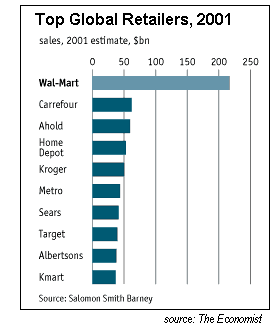 1. Size matters. Wal-Mart is by far the world's largest retailer. Though this
chart is a bit dated (2005 sales at Wal-Mart exceeded $285 billion, and 2006 sales are on
track to hit over $300 billion), the relative weight of Wal-Mart compared to its global
competitors hasn't changed. It is the proverbial 800-pound gorilla. Its policies can
literally move the world.
1. Size matters. Wal-Mart is by far the world's largest retailer. Though this
chart is a bit dated (2005 sales at Wal-Mart exceeded $285 billion, and 2006 sales are on
track to hit over $300 billion), the relative weight of Wal-Mart compared to its global
competitors hasn't changed. It is the proverbial 800-pound gorilla. Its policies can
literally move the world.
2. Wal-Mart very ably tells its side of many issues on this website,
Wal-Martfacts.com which I recommend checking out.
3. For a variety of reasons, Wal-Mart excites emotional responses in many of us.
I believe the reader-commentators I quote at length below make valid points and ask valid
questions which are not emotionally biased; while I do not have answers for all the issues
raised, I would like to clarify my own position. (Feel free to scroll down and read the
corresponents comments first and then return to my own comments.)
4. I don't "hate" Wal-Mart but I do see evidence that they rely on taxpayer funding as
part of their low-cost business plan--something which not all their competitors do.
Hence, they
are gaming the system to the disadvantage of taxpayers. That is my core objection. If one
retailer gets to off-load healthcare coverage onto the government/taxpayers, then
all retailers should be
offered that same advantage via a "level playing field."
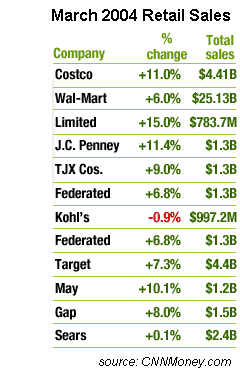 If one retailer pays a decent wage and provides its employees with some medical insurance
and 401K-type pension, while another pays lower wages and few benefits, because it knows
the government will provide those for its employees if it doesn't, then who wins in the
long run? The competitor (Wal-Mart) who is basically using the government to pay some of its
employee benefits (medical and retirement).
If one retailer pays a decent wage and provides its employees with some medical insurance
and 401K-type pension, while another pays lower wages and few benefits, because it knows
the government will provide those for its employees if it doesn't, then who wins in the
long run? The competitor (Wal-Mart) who is basically using the government to pay some of its
employee benefits (medical and retirement).
Wouldn't it be fairer to require a level playing field for all retailers? In Hawaii, for instance,
a law requires employers to pay 50% of all employees' medical insurance, regardless of the
firm's size. (I think the cut-off is 20 hours per week, which of course can be evaded by hiring people to work
18 hours a week). The idea is, all employees get some help in medical coverage, and all
employers pay some of those expenses. Hence: a level playing field.
5. The alternative is what Japan and Europe offer employers and citizens: the government provides the medical
coverage, freeing all employers equally from that burden. What strikes me as patently
unfair and thus uncompetitive about Wal-Mart et. al. is that the government picks up the
tab for thousands of their employees while other global corporations such as Ford, Boeing,
Costco, Hewlett-Packard, etc.
cover all or a significant portion of these costs.
6. As for China and other low-wage havens, let's look at what U.S. retailers can do, even in
a global workforce situation. If U.S. corporations require overseas contract employees to be paid, say,
$120 rather than $80 a month, and that their work hours be limited to 10 hours per day, etc.,
then some factory will switch over to meet those standards in order to serve the U.S.
market--or Wal-Mart alone, since it is basically a small nation in and of itself.
Their competitors will eventually
find it hard to recruit the best workers, as they have migrated to the better
wages and working conditions of the factory meeting U.S. standards.
Since factory wages are such a small part of the final product's retail cost, U.S.
retailers such as Wal-Mart can improve the global working conditions and wages for many
workers without unduly jeopardizing their global competitive position. Companies such
as Hewlett-Packard have made an effort to require minimal standards for the workplaces
of their contract manufacturers (OEMs) in China (including inspections to oversee compliance);
if H-P can do it, then why can't Wal-Mart?
7. The argument that requiring Wal-Mart to pay modest benefits and decent wages would
significantly impact its low-income customers is false. A 20% increase in wages and benefits
would not translate into a 20% rise in the retail cost of goods. Although I cannot locate
any statistics to use as metrics, I suspect the entire
year's impact of slightly higher prices would be equivalent to about the cost of
one meal for the family at McDonalds and an armfull of DVD rentals. Yet the impact on the
employee would be very significant.
To summarize one argument offered in favor of the Wal-Mart model: their low prices outweigh
the low wages if you
consider the benefits to the entire community. But this is a false analysis. The question should be: how
does Wal-Mart compare against a competitor such as Costco which pays decent wages and benefits
while also offering low prices? Are Costco prices low enough to save consumers money?
Yes. Do they pay employees more than Wal-Mart? Yes. Do they still make a profit? Yes.
(While I know Costco pays well anecdotally, I was unable to find statistics to back this up--
if anyone has comparative stats on wages and benefits paid by Target, Costco and Wal-Mart,
I would appreciate a link.)
8. This discussion also raises another theme with which readers of this blog are familar--the looming
crises in American healthcare (or lack of it). According to The Wall Street Journal,
the number of people without health insurance increased to 46.6 million in 2005.
(About 45.3 million people were without insurance the year before. Hey, a million here and
a million there, and pretty soon you're talking about a lot of people.)
Then there's the millions of people like myself, self-employed or small business owners,
who are hanging onto their insurance coverage by a thin thread.
Many people (myself included) believe that the U.S. will get a national healthcare plan
only when Corporate America finds their medical costs so heavy that
there is simply no other way to stay in business but to off-load healthcare onto
the Federal government. At that magical tipping point, all the objections and all the
rah-rah about free enterprise will suddenly vanish, because profits (or in the case of
the U.S. auto industry, their very survival) will be at stake.
In summary: Global corporations can afford to pay their employees wages and benefits
such that said employees don't need public assistance to live. If we as a nation want
retailers to offer some form of work-welfare, then all retailers should share the same
government benefits/support structure.
OK, on to the readers' commentaries. Here is one who points out that small business games the system by paying wages
under the table, avoiding both taxes and benefits costs:
My first "real" job back in 1979 was inside a grocery store (I was the clean up boy in the butcher shop working for $2 an hour cash + free cokes and candy). When I graduated from High School in 1983 I had moved on from clean up boy to carry out boy to cashier and weekend manager of the little Burlingame store. The Italian Immigrants that owned the place never put me on payroll, paid any taxes or gave me any health care but they more than doubled my salary to $5 an hour cash + let me have a case of beer every now and then...
I had to laugh when I read: (from a previous entry on Wal-Mart, link at the end of 8/29 entry)
"The low wages and benefits paid by Wal-Mart insures that a significant percentage of their workers' medical costs are paid by taxpayers via Medicaid. Yes, Medicaid--the medical benefits reserved for the poor of our nation. Those $7-8/hour jobs place the workers solidly in the extreme poor of our nation, those earning $15,000 or less annually. (This is more than most writers earn by scribbling, but that just shows lousy pay isn't enough to deter fools.)"
I know it is popular to hate Wal Mart, but what is the difference between Wal Mart paying $8 an hour without any health care and some hip Berkeley coffee shop paying $8 an hour without any health care. The difference is that while Wal Mart may not pay high wages, and they may not pay heath care, but at least they hire legal Americans and pay taxes (I know that a company Wal Mart hired to clean stores did get caught with illegal aliens). Almost everyone I know in the restaurant, retail and real estate business hires more illegal aliens, pays less total cash compensation and pays less taxes to the government than Wal Mart...
I do a lot of retail lending and addition to your blog I read
www.morningnewsbeat.com
(which has a "Wal Mart Watch" section)
on a regular basis. Sure Wal Mart and Super Wal Mart are making it hard on other retailers,
but Safeway and Luckys forced the closure of almost all the little stores in SF where my
parents shopped as kids and most of the little grocery stores on the Peninsula
(including the one I worked at).
It is not popular to say this but the small business that are much loved by the liberal
left are a "double whammy" to the economy. Not only do most small and family business
hire as many illegal aliens as possible (and pay rock bottom wages) or pay US citizens
cash but they avoid lots of income taxes by rarely declaring much (or any) of their
cash income.
As a commercial real estate lender I see the tax returns of all our small business owning
Borrowers and many of these guys worth millions "make" (according to their tax returns)
about as much as a Wal Mart employee or a struggling writer. As much as people hate Wal
Mart at least they withhold taxes from paychecks and have audited financial statements
and pay taxes on their income.
Next up is correspondent Michael Goodfellow, who last contributed an incisive analysis of
the looming Social Security crisis. He observes that the key drivers to many of these issues
are larger than Wal-Mart: technology and education:
Wal-Mart seems to have become a symbol of globalization (especially goods from China) and
low-paying jobs in the U.S.. Wal-Mart stores have drawn a lot of local opposition from
activists, despite their popularity with shoppers. States like Maryland are trying to
force them to provide health insurance. I would really like critics to give honest
answers to the following questions:
1. Why is there a huge line of applicants for those crappy Wal-Mart jobs whenever they open up a new store? Do none of those people know how horrible it all is?
2. The "taxpayer subsidy" critics mention is of course government programs like food stamps and Medicaid, which large families with low income qualify for. Wal-Mart is hardly unique in this since they pay well over minimum wage.
So the current situation is that all taxpayers fork over a bit of money to low-paid workers. If Wal-Mart raised its compensation they would also raise their prices to pay for it. So then you'd have Wal-Mart customers paying extra to subsidize low-income workers. But since Wal-Mart customers are disproportionately low-income themselves, the price increase would hit the portion of the population least able to afford it.
What's more, if Wal-Mart is required to offer health insurance, they would rationally discriminate against elderly employees, part-timers or ones with families. Is this really what you want?
3. If Wal-Mart didn't exist, would China raise all its prices and pay all its workers more? Or would they just sell to other retail outlets? If they did get more for their goods, would any of that reach workers there?
4. Third-world workers in general are not slaves. Press gangs do not drag them off the streets to make Nikes. If they have taken a job in a sweatshop, it's because that's the best job they could find. If you close that factory, won't they just go to the next, crappier job that they had previously turned down?
5. If you make third world countries obey U.S. environmental standards and working standards and pay standards, what advantage would they have left? It's not like they have a better educated workforce or anything else to offer. Cheap labor is their only way into the world market. It's their first step up the ladder to first-world status. This has worked for Japan, South Korea and now China. Why would you want to stop it?
6. In more socialist countries, Wal-Mart might not exist. Instead we'd have a core of long-term unemployed people like in Europe, plus expensive retail with poor service. Is that better?
The point of these questions is that by slapping down Wal-Mart and what it stands for, you might not be helping anyone, least of all the low-wage employees you are so worried about.
It's also worth wondering why Wal-Mart exists in the first place? The criticism of Wal-Mart makes it sound like a symptom of moral decline. Weak unions, Big Business exploiting workers with crappy wages, slave-labor economies in China, etc. It's far more likely to be due to changes in technology.
For example, consider overseas call centers. You might explain these as simple greed -- corporations reducing their costs by sending jobs overseas. But companies have always wanted to reduce their costs. Why didn't they send those jobs overseas 30 years ago? The answer is technology. Back in the 70's, overseas calls were something like $1 a minute. If an Indian worker was paid 50 cents an hour and an American $6, it didn't matter, since the phone call was $60 an hour. Now the cost of phone calls has dropped to a couple of cents a minute (a dollar an hour) and suddenly an overseas call center makes a lot of sense.
I've read similar things about containerized cargo. Before that was introduced in the 60's and 70's, cargo was unloaded and repackaged multiple times in transit. With containers, it all moves more cheaply, more quickly and more reliably. This in turn enabled all the just-in-time worldwide supply chains that make a company like Wal-Mart (and many other companies) possible.
Cheap computers and networks are also a factor. I've read that Wal-Mart is as much an information technology story as it is a retail story. After all, according to their annual report, they have 1.6 million employees, 68,000 suppliers, and thousands of stores. Getting everything where it should be in a network this size just wasn't possible back before computerization.
We want cheap phone calls, cheap computers and cheap shipping. The side effect is global supply chains and the creation of large companies like Wal-Mart and all the other big-box stores that are killing small retailers. When retailing becomes a technology and supply chain story, the "mom and pop" stores just can't compete.
Finally, wages would be higher if there weren't a worldwide oversupply of unskilled labor. This is especially ridiculous in the U.S. considering how much we spend on primary education. A high-school graduate here has received anywhere from $70,000 to $150,000 in education. It's a crime that for so many people, this expensive education gets you the skills to tote boxes around at Wal-Mart, or compete with nearly illiterate factory workers in third world countries. We should be moving up the chain and producing more valuable goods. Wal-Mart should be forced to pay more wages, not because government passes a law, but because there are so few people who want those jobs.
I don't see this situation getting any better. As technology improves, more and more low-skilled work will be automated. We've let education stagnate for years, with only trivial increases in test scores. The tests themselves measure little that has any value in getting a job. Large numbers of low-income people willing to work for Wal-Mart wages is the price of that neglect. It's not a story about greed.
Thank you, Michael and our other reader, for such cogent commentaries. Thanks to you,
I have a better understanding of the issues raised by critiques of Wal-Mart.
August 30, 2006
You Can't Have It Both Ways
A great conundrum now faces the Federal Reserve. Should they continue to raise
interest rates to quell inflation and support the dollar, or should they begin
to drop rates to counter the slowing U.S. economy? There are good reasons to want both--
a low-inflation, strong-dollar economy and an easy-money economy where virtually anyone
with a job can borrow lots of money cheaply.
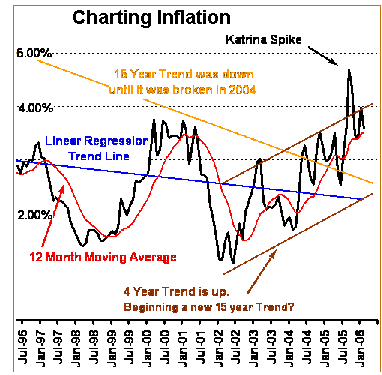 Ah, but you can't have it both ways. Either way the Fed goes, they will get
the same result--recession. Wait a minute--how is that possible? Read on.
Ah, but you can't have it both ways. Either way the Fed goes, they will get
the same result--recession. Wait a minute--how is that possible? Read on.
Just for laughs, let's say the Fed is under tremendous political pressure to keep this
debt-based, housing-based, asset-bubble-based "prosperity" running at least through 2008.
(As to why this might be so, I'll let you fill in the blanks: to stay in power you must
win elections. To win elections, you must fatten the wallets of voters and provide them
with a happy story about the golden future just ahead.)
The Fed has only one hope to accomplish this--begin dropping rates from 6% back down to
3% or less. We all know a quarter point here and there is meaningless; to re-inflate the
housing bubble and re-ignite consumer borrowing, the Fed has to pump heavy steroids into
the economy--massive liquidity, easy borrowing standards, and low rates.
But hey, don't they already provide the first two? Yes, they do. And if that's not working,
then the only stimulant left is much lower rates. But will there be any consequences to
lowering rates? Maybe this time there will be. Our exporting trading partners,
Japan, Europe, China and the OPEC oil producers, have willingly (or unwillingly, who knows)
entered into a devil's pact with us akin to the pusher and the drug addict. They buy our
bonds (that is, our IOUs or debt) to keep the dollar afloat and their currencies weak,
and in exchange we buy about $1 trillion more of their exports than we can afford (the
trade deficit). They sell all this stuff to us to support their economies, and to enable
all that borrowing, they pump their profits back into the dollar and bonds.
We're both addicts, actually, and both pushers: they need our market to keep going, and
we need their cash/savings to keep our debt/borrowing/spending raft afloat. But observers such as Warren Buffett have
long feared that this imbalance will come to a bad end, and that the dollar will at some
point suffer a serious devaluation.
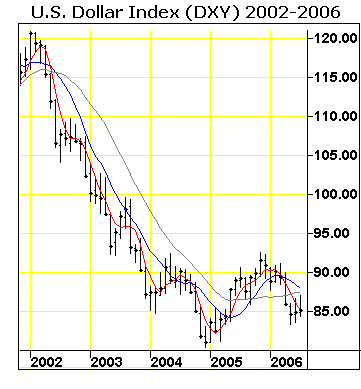 What could trigger such a devaluation? An abandonment of the dollar by foreign investors
who suddenly realize even their massive buying can no longer keep the dollar high. Or
perhaps Venezuela, Iran and Russia announce that they're pricing their oil in euros. The
final straw is unknown, but the risks, at least to people like Buffett, appear to be growing.
(Correspondent Wayne D. has posted Buffett's comments on
his board,
Warren Buffett on the dollar.)
What could trigger such a devaluation? An abandonment of the dollar by foreign investors
who suddenly realize even their massive buying can no longer keep the dollar high. Or
perhaps Venezuela, Iran and Russia announce that they're pricing their oil in euros. The
final straw is unknown, but the risks, at least to people like Buffett, appear to be growing.
(Correspondent Wayne D. has posted Buffett's comments on
his board,
Warren Buffett on the dollar.)
For more of Buffett's views, go to the Berkshire Hathaway annual report and scroll to
pages 18-25
But as I argued in a November 10, 2003 article in Fortune, (available at berkshirehathaway.com),
our country’s trade practices are weighing down the dollar. The decline in its value has already been
substantial, but is nevertheless likely to continue. Without policy changes, currency markets could even
become disorderly and generate spillover effects, both political and financial. No one knows whether these
problems will materialize. But such a scenario is a far-from-remote possibility that policymakers should be
considering now. Their bent, however, is to lean toward not-so-benign neglect: A 318-page Congressional
study of the consequences of unremitting trade deficits was published in November 2000 and has been
gathering dust ever since. The study was ordered after the deficit hit a then-alarming $263 billion in 1999;
by last year it had risen to $618 billion. (note: it has since risen to over $800 billion.)
Some observers believe the dollar is fundamentally more valuable than competing currencies
(for instance, Mish), but there are technical analysis reasons to suspect the dollar could
drop from 83 on the DX index (click here to see the chart) all the way down to 52--a 37% devaluation.
Were this to occur, what would happen? To start with, imports from everywhere but China
would rise by that 37%, and our exports would get a 37% discount. There are all sorts
of consequences of such a massive currency adjustment, consequences which interact in
unpredictable ways.
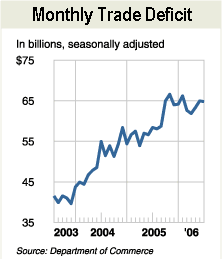 For instance, since we import so much, then a big jump in import prices would feed inflation:
we're paying more for the same goods. Except from China, of course, which pegs the yuan
at 8 to the dollar. A dollar devaluation would be a boon to China, as it would discount
their goods in Europe and Asia while leaving exports to the U.S. untouched. In that sense,
a dollar devaluation would be favorable to China, and not something they would fear. Perhaps
they would even welcome it as a support to their exports and a "tax" on imports from Japan
and Europe.
For instance, since we import so much, then a big jump in import prices would feed inflation:
we're paying more for the same goods. Except from China, of course, which pegs the yuan
at 8 to the dollar. A dollar devaluation would be a boon to China, as it would discount
their goods in Europe and Asia while leaving exports to the U.S. untouched. In that sense,
a dollar devaluation would be favorable to China, and not something they would fear. Perhaps
they would even welcome it as a support to their exports and a "tax" on imports from Japan
and Europe.
Meanwhile, the oil exporters would suffer a 37% haircut--a haircut they are unlikely to
enjoy. Since oil is priced in dollars, they would get 37% less for their oil--unless, of
course, they spent that money in the U.S. Then their purchasing power would remain the same.
One could easily make the case that the U.S. would welcome such a move, as it would bolster
our sales to the oil-exporting nations. Japan and Europe would welcome such a devaluation as
well, as it would immediately drop the cost of oil in their currencies by 37%--a very hefty
discount. Again, the devaluation would be neutral to China, as long as its currency
remained pegged to the dollar.
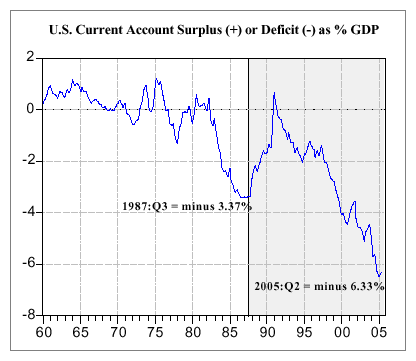 But in another way, Japan and Europe would
certainly not welcome such a devaluation, as it would impose an instant 37% "tax" on their
exports to the U.S. Which is more important--cheaper oil or exports to the U.S.? That
is yet another sticky wicket.
But in another way, Japan and Europe would
certainly not welcome such a devaluation, as it would impose an instant 37% "tax" on their
exports to the U.S. Which is more important--cheaper oil or exports to the U.S.? That
is yet another sticky wicket.
If, however, the oil exporters are unhappy with their haircut, they could decide to price
oil in a basket of currencies rather than the dollar--a move which would instantly raise
the cost of oil to the U.S. That move alone could trigger a recession in the U.S., even
if the 37% increase in the cost of imported goods failed to do so.
The consequences of a dollar devaluation are uncertain, as they are negative for some
global players and positive for others. Such a dislocation carries high risks for the U.S.
and the global economy.
One way to avoid this mess would be to support the dollar with higher interest rates.
But if the Fed raises rates, it will likely tip the U.S. economy into recession. Ah,
but you can't have it both ways.
August 29, 2006
Another Perspective on Wal-Mart
 I am continually astonished (and of course gratified) by the high bandwidth, knowledge
and experience of this humble site's readers. You, the readers, provide information
to your fellow readers which is often unavailable elsewhere.
I am continually astonished (and of course gratified) by the high bandwidth, knowledge
and experience of this humble site's readers. You, the readers, provide information
to your fellow readers which is often unavailable elsewhere.
In that spirit, I offer you one executive reader's experience with that colossus of global
retailing, Wal-Mart. (My own view is encapsulated in the accompanying graphic.
Any corporation which relies on taxpayer-funded programs to provide medical care for its
employees while it makes billions in profits does not win any "good corporate citizen" awards
in my book. Let's call it what it is: a corporate leech on the body of the Republic/corporate
welfare recipient. If "always low prices" saddles we the taxpayers which billions in
additional expenses which competitors such as Costco somehow manage to pay themselves,
then are those "low prices" truly low or merely subsidized?
For a look into the inner workings of Wal-Mart, let's turn to our first-person account:
Approximately a year ago I was contacted about being the CFO for
Wal-Mart's real estate company. Just the annual capital budget ran approximately $6 billion.
It also had a large staff--approximately 150 people. Anyway after several telephone
interviews Wal-Mart asked me to fly out and meet them.
I ended up taking a flight out of a west coast airport that got me into Northern Arkansas
airport at something like 10:00. Let me tell you it is dark in Northern Arkansas at 10:00
P.M. and I got lost driving to Bentonville. Now this is kind of funny since I have lived
on four continents and travel the world with a map and hardly ever get lost. I currently
fly all over the country to some of its major cities and never get lost, but it was so
dark and the road signs if they existed at all were so small I could not see them. Anyway,
to make a long story short I get to my room at approximately 1:00 am.
It is a $50 room even though there is a Hilton Inn down the road which might cost $20 more
but would be a much better room. There is a lot of noise from pick-ups driving around at
night with modified exhausts (even though I live in a major city I am from a similar area
so I am not an elitist). Anyway I get up at 5:30 am so I am lucky to have 3 hours of sleep.
I drive to Wal-Mart and start the interviews at 8:00 am. These last for 8 hours. Lunch
is a bottle of water and a protein bar which I ate while walking down a hall. I finally
get out and have to drive to the airport. I make it back to the airport and have a raging
headache. I catch a flight somewhere around 7:00 am. I am worn out by the time I get back
to the west coast.
Now this is the kicker. I never ever hear back from them. Not even a “Thanks but no
Thanks” letter and even though they have my email address I don’t even receive a two word
email like "You suck." Nothing!
Now I have my own consulting business and at that time I was very busy. A chargeable day
could bring in a significant sum when I am working on a project like I was at that time.
So in my case time really is money. The HR department had a large number of executive
recruiters and support. What would it have taken to send an email?
In summary, I was very unsure about Wal-Mart. I knew they treated their staff even worse
than most retailers and they have a turnover of close to 50% or more a year. I also do not
support bringing in all of the goods from basically what I look at as slave labor camps
(I am a true believer that if people do not pay employees a decent wage there will soon
not be anyone in this country to buy anything). Finally, I find the quality of the goods
leaving much to desire. Also going from the west coast and NYC where we lived previously
to NM Arkansas would have been a big change.
With that said my mother had cancer surgery a few months before and I would have been
closer to where she now lives. We are both from the South Central part of the United
States and so it was not like we have never been in this culture before. Also, we are
kind of burned out with the West Coast and thought the change would be interesting.
But after never hearing anything from them, all I can think is if this is how you treat
let us say one of the top 30 or so executives in the organization then how do you treat
the bottom level of people who work in your stores. The whole of Wal-Mart is just an
extension of the slave labor environment in China.
To be fair, we have to ask: do Wal-Mart's global competitors, Carrefour (France),
Tesco (U.K.), Bailian Group (China) or Aeon Co and Ito-Yokado (Japan), treat their
executives and employees any better than Wal-Mart? We cannot easily reach an
answer, but we can be appalled by the shoddy treatment offered by Wal-Mart headquarters,
and note that all the go-go hype about China neglects to mention the tens of millions
toiling for less than $100 a month making all the goods which line Wal-Mart store shelves.
The term for this pervasive low wage is the high-falutin' sounding term "global wage
arbitrage." I would call it by a simpler name, exploitation, and
reckon that such distancing terms as global wage arbitrage are masking the brewing of
the next Chinese Revolution as 300 million underpaid, uninsured and pensionless workers
observe the prodigious inequality of their society, i.e. the vast wealth
being accumulated by the 30 million at the top.
As our correspondent observes, perhaps there is a link between Wal-Mart's standards for
its Chinese subcontractors and its U.S. employees: the true cost of "always low prices,
always."
Here are my previous entries on Wal-Mart:
That Price Isn't Cheap, It's Subsidized
The Most Hated Company in America
August 28, 2006
Welcome back, Readers! Today's entry: Stories from the Housing Bubble
 Herewith are two stories of the Great Housing Bubble Pop, which we are
witnessing in a weird, slow-motion implosion sort of way. The first story comes from a Comcast
cable installer, who works as a subcontractor for Comcast.
Herewith are two stories of the Great Housing Bubble Pop, which we are
witnessing in a weird, slow-motion implosion sort of way. The first story comes from a Comcast
cable installer, who works as a subcontractor for Comcast.
In the course of a leisurely chat (no, we're not getting cable TV, or DishTV, thank you very much--
recall that I am a poor writer), this hardworking gentleman mentioned that he and his wife
were backing out of the purchase of a 5-bedroom "mansion" (his word) outside of Marysville, CA,
which lies far to the northeast of the San Francisco Bay Area and about 40 miles north of
Sacramento.
They had re-financed their North Bay home and had about $100,000 sitting in the bank, when
a "helpful" relative had convinced him that the money was not doing him any good in a bank
and should be "put to work" in real estate.
The couple already owned a home in the North Bay, and had signed up for the new mansion
when the prices dropped from $450,000 down to $350,000--a recent price reduction which occurred
even before the home was completed. Upon further reflection, however, the subcontractor had
decided to exit the deal before closing escrow for this simple reason: hundreds upon hundreds
of nearly identical "mansions" are sitting for sale, or are under construction in the vast
"desolate" (again, his word) plains surrounding Sacramento. This fellow (working six days a
week by his account, and since it was Sunday, I had no reason to doubt him) had grasped the
nettle, i.e. that such an astounding oversupply could only engender further price drops.
His realtor, rather unsurprisingly, had suggested closing on the house and renting it out.
But our man had enough moxie to know that rents--based on the lower wages--in such a distant exurb
would be far below his carrying costs. His wife had cautioned him that she wouldn't rent to
families with children, at which point the gentleman observed 1) this was discrimination
(another sign this guy knew the realities of landlording/renting) and 2) "who else but
a family with children would rent a 5-bedroom house?"
To top it off, our source had been informed in a sort of legalese aside that he would be
saddled with a $200/month payment for levee improvements on a nearby
river. Upon being re-assured by the salesperson that "there hasn't been a flood in 100 years,"
our source replied, "Then it's about time, isn't it?" When I wondered aloud who had built
these levees, he replied, "Exactly. I'm not doing a Katrina."
This gentlemen had also pondered their initial reason for buying the house--as their retirement
dream home--and concluded that the lack of nearby amenities and amusements (i.e. the
subdivision was plopped in the middle of nowhere) that he and his wife would be reduced to
sitting in this giant house with nothing to do but get on each others' nerves. Now here is a
wise man!
Our source concluded by noting that he'd told his wife that the purchase of this second
home could end up costing them both of their homes. I did not think it proper to inquire
if he would lose his earnest money deposit, but regardless of that
loss (if any), he had clearly reached the right and proper conclusion--closing on the
second-home "mansion" would be a financial catastrophe.
Our second story comes from a friend who moved from the dot-bomb wreckage of Silicon Valley
in 2001 to the warmer climes of Florida. He and his wife had purchased a recently built
home in an upscale coastal community for about $340,000. On a recent visit to California
to explore moving back (public schools were inferior, even in his community,
the private school his son was attending in Florida was hideously expensive, job opportunities
were thin, etc.), he mentioned that they'd pulled out $150,000 in equity over the past
five years, and that the money was gone--family medical expenses, replacement vehicle,
private school, etc.).
A quick search on zillow.com revealed that his house was valued at about $600,000--based, of
course, on recent bubblicious sales--but he reckoned $550,000 was a more accurate number.
(Zillow fiends, beware.) With the $150,000 re-fi equity extraction, his mortgage was now
around $450,000 (they'd only put 10% down). Our friend claimed the eastern seaboard had been
largely unaffected by the big price declines hitting Florida real estate (a claim I can
neither confirm nor deny), but if the value of his house were to decline to $500,000, it
seemed that he was, after paying a 6% commission and closing costs, rather dangerously near
the value of his mortgage. In other words, a sale of his home in the $500,000 range
would net him perhaps his original 10% down payment of $34,000.
Here we have two common threads: massive equity withdrawals which have either been spent
or "invested" in risky real estate wheeling-and-dealing, and would-be landlords realizing that
local rents cannot pay their carrying costs. Neither homeowner mentioned the elephant
in the room: with prices in decline, equity extraction is a thing of the past. A lifestyle
which absorbed $150,000 over five years in "free money" (the equity extracted and spent)
will now have to downsize to mere income.
Multiply this by millions of homeowners, and then ask: what will happen to the
"healthy" U.S. economy when people can no longer freely borrow and spend huge amounts of equity?
As a lagniappe, we have the looming issue of inadequate levees, not just in the Gulf
states but in California. The "hasn't been a flood in 100 years" salesperson is either
ignorant or confused; there have been many instances of flooding in the Sacramento River
basin, up to and including collapsing levees. It is well-known in Sacramento that thousands
of recently constructed homes sit in flood plains. As to whether the new owners are aware
of the flooding risks--they sure give you a lot of forms to sign in escrow, don't they?
August 19, 2006
Will The Market Rally in Fall?
and... A Brief Vacation Hiatus
Astute correspondent S.B. recently posed a most interesting question:
Buying the S&P500 in the fall of a mid-term presidential election year,
and holding for one year, has given returns of 20 to 50%. I don't think
there are any exceptions, and this has worked since the 1930's.
But with the housing slowdown and consumer spending really slowing, how
can the stock market rally? Can it rally in the face of declining
earnings?
Will this year be different? Will the mid-year election cycle rally fail
to occur?
Maybe an interesting topic to cover....
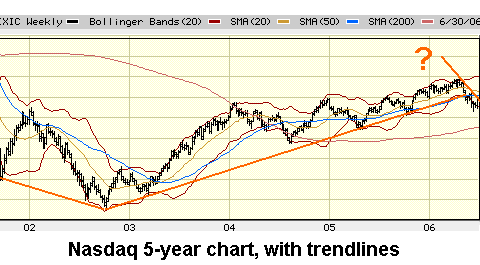
To help answer this excellent and timely question, I asked knowledgeable correspondent
H.I. if he could shed some light on the matter. He sent the following comment and two
charts which display the market positions of professional traders (who are decidely short/negative
the market) and retail traders (us amateur types) who are decidedly long/positive the market:
For your consideration: two charts. This
document is in PDF format and requires Adobe Reader (free from adobe.com)
For a deeper analysis of the market from a technical analysis/historical perspective, H.I.
suggested
Return of The Bear
by technical analyst and author Martin J. Pring. This is a 27-page overview with a great number
of charts. I highly recommend it to anyone who wants some long-term insight into the current stock market.
My own rough-and-ready view is this: nothing goes down in a straight line. The four-year
cycle (discussed here before) suggests there will be a sharp decline/bottom in October 2006.
It would be in the nature of the market to bounce from that low sometime in the
November - January 2007 timeframe. But as to whether that bounce will last... I think S.B.
has hit the nail on the head. With consumer spending questionable, and corporate profits
heading for decline after years of stupendous gains, what could sustainably power the market
higher? Lacking an answer to that, it seems improbable that the market can manage more than
a bounce after the coming October low. But we shall see....
Vacation Hiatus
While some hardy bloggers manage to post during their vacations, I am not one of them,
so my next entry will post on August 28. In the meantime, I offer up several sources
of entertainment/amusement/ideas:
1. an extensive archive of previous entries on a very wide
range of subjects (organized into 21 categories--you're sure to find something of passing interest)
2. a list of recommended books/films
(organized into 11 subjects plus films)
3. an archive of published articles
on a range of topics
4. the nearly-impossible-to-solve-but-fun-anyway I-State Lines contest (In part II, an interest in cryptology puzzles
will be helpful)
5. a variety of stories: Claire's Great Adventure (for teens),
The Adventures of Daz and Alex:
Stories of America (the characters in my novel
I-State Lines),
and forbidden stories (as
they say in the movies, some of which "depict adult themes and settings")
6. my novel
I-State Lines ($20 from the
The Kaleidoscope indie bookstore, shipping free, or $13 from
Amazon.com shipping free for orders over $25--i.e., buy a copy for yourself and one as a gift for a
young adult on your list)
shipping free for orders over $25--i.e., buy a copy for yourself and one as a gift for a
young adult on your list)
If you like my writing here, you'll probably like my writing in the novel, too. If you don't
typically read fiction, then just tell yourself it's non-fiction; it is a road/travel novel,
so that's not much of a stretch. And if you read three chapters every night (they're short),
then you'll be done by the time I get back to posting new material here. What could be more
perfect than that?
In the meantime, thank you for your readership, and I hope you won't forget this little corner of
the Web in my brief absence.
August 18, 2006
The Future of Real Estate Investment Management
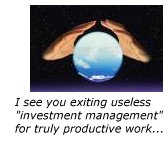 Looking into my cracked crystal ball, I caught a glimpse of a certain Joe E. Blow,
Real Estate Investment Management, and was able to discern how his marketing campaign changed in
the future. I might have missed a few details in the blurry fog within the crystal,
but this is what I saw:
Looking into my cracked crystal ball, I caught a glimpse of a certain Joe E. Blow,
Real Estate Investment Management, and was able to discern how his marketing campaign changed in
the future. I might have missed a few details in the blurry fog within the crystal,
but this is what I saw:
May 2005:
Joseph E. Blow
Real Estate Investment Management
I can help you locate, finance and trade properties in all 50 states:
Second homes
Oceanview investment properties
farmland and forestry investment opportunities
preconstruction investing
No documentation adjustable-rate loans
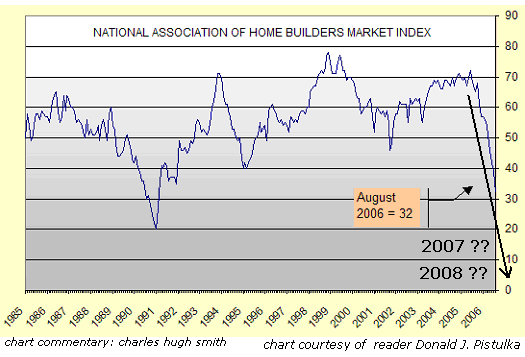
May 2006:
Joseph E. Blow
Real Estate Investment Management
I can help you sell properties in all 50 states:
Second homes
Oceanview investment properties
farmland and forestry parcels
first-rate staging services
re-finance ARMs to fixed-rate loans
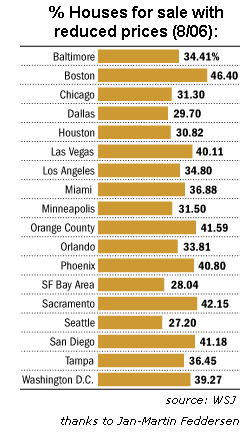
May 2007:
Joseph E. Blow
Real Estate Foreclosure Management
I can help you exit problem properties in all 50 states:
negotiated foreclosures
bankruptcy attorney referrals
tax liability management
online auctions (in yuan, yen and euros)
depression/loss/financial counseling
May 2008:
Joseph E. Blow
Real Estate Management
I can help you care for your property:
yardwork
maintenance and repair
pet care/dog walking
eBay sales of your remaining valuables
garage sales are my specialty
solar panel installation
May 2009:
Joseph E. Blow
Services and Sales
Your source for service!
full line of energy conservation products
solar panel installation
vacation pet care
yard maintenance/water conservation
wheatgrass/interior gardening
custom quilting/re-caning service
Isn't it great how Joe transformed himself from an entirely non-productive citizen in 2005,
producing nothing of value, into a productive entrepreneur providing an array of services
by 2009?
August 17, 2006
House of Flying Cliches

 There's nothing more lethal in movieland than a razor-sharp flying cliche, and
House of Flying Daggers
There's nothing more lethal in movieland than a razor-sharp flying cliche, and
House of Flying Daggers has nearly as many cliches as it does daggers.
has nearly as many cliches as it does daggers.
OK, so this film is fantasy, through and through. Every dagger finds its mark, every arrow
hits dead-on (unless it's a ruse, in which case it magically only sticks in clothing--now
there's a magic arrow for ya!) But even fantasy films have to present a semi-realistic
emotional world if they are to engage the audience. "Flying Daggers" fails miserably to do so.
We are introduced to a beautiful blind courtesan--who happens to be a wonderful dancer.
Woah, amazing how someone who can't see could do all that and not run into something.
Do ya reckon anyone might want to try a simple test to see if she's really blind, like
throw a fake punch and see if she blinks? Nah.
Then the beautiful dancer waits for a troop of heavily armed soldiers to show up before
announcing her hatred of authority--nice timing, girl! And then she reveals her stunning
martial arts ability--dang, never woulda guessed it!
But here's the real hack. This gorgeous young thing--Zhang Ziyi--who can kick serious butt
at the drop of, well, just about anything, struggles futilely while nearly being raped by
not one but both of her paramours (at different points in the story, of course), and has
to be ignominously saved by someone. And then
instead of slipping a dagger in the gullet of her rapacious suitor, she plays coy! This
isn't just fantasy, it's sick fantasy. Go ahead and try to force yourself on a beautiful
blind girl, because she's suddenly helpless against your lust--and she'll still be goo-goo
eyed for you after. Gag!
But wait--wasn't she in a brothel? So what? Brothels don't condone rape; you pay your
money and accept the service rendered. You don't start ripping the clothing off the joint's
prize dancer unless you want one of your kidneys skewered. There is simply no excuse for
this guy's rapine ways, and no dramatic purpose, either. Yes, Zhang is beautiful, but forcing
oneself on a dancer is not a sign of desire, it's violence pure and simple, fantasy or no
fantasy.
And never mind what she doing in a brothel to begin with--pesky plot lines
are just jumbled together more or less randomly, with no explanation given. She's supposedly
seeking to revenge her father (martial arts film cliche Number 1), but how she planned to
do so from the interior of a fabulous brothel (more like a palace--talk about fantasy!)
is unexplained. The setting appears to have more to do with a teenage boy turned
screenwriter's fantasies about Zhang than a coherent plot
As if this wasn't bad enough, then we get a hoary "tragic" ending: the girl ends up
getting killed while the two rivals for her affections both survive. Now this is realistic,
right, because in real life the jilted guy always kills his lover, not his rival, right?
Right! But do we have to glorify that personification of pathetic male ego run amok? I
was hoping both of the loser guys would adios each other and leave Zhang alone to find
a decent guy. But no, she gets killed off and the two sleazebags survive to nurse their
broken hearts. Gag!
The final fight sequence is so laughable that I could barely finish watching it. Let's see:
two guys are swinging heavy swords at each other, plus kicking and punching and rolling around
grunting, and they start in Fall (cue the dappled leaves on the trees) and continue into
Winter (cue the snowfall). Meanwhile, the woman they each supposedly love (or love enough
to force themselves on--now that's love!) lies near death nearby, ignored.
Uh, have you ever been in a real fight, or even seen one? In the famous real-life showdown
between Bruce Lee and his martial arts master challenger--not the movie showdown, the real one which
occured in the late 60s--Bruce supposedly bested his opponent but found himself exhausted after
only 3 minutes of battle. A few minutes of real fighting exhausted one of the greatest
martial arts practitioners in the world! (This experience prompted Lee to increase his
conditioning.) And yet in the movie, these guys are still going at it for hours,
if not days! Even if you allow this as fantasy, what about them leaving the woman they
both love to die while they duke it out? That has zero emotional realism, and yet their
rivalry for her is the heart of the entire story.
This movie has no emotional center. The love story here is too unbelievable and cliched to
even hold up as fantasy. The "love" we're shown here--the kind in which "passion" drives the
guys to force themselves on the object of their desire--is hardly the sort of "affection"
which a girl will respond to positively, especially one who possesses supreme martial arts abilities.
And if she's so good, how could she fall for the old "two daggers in one" trick her
jilted lover pulls on her? Isn't it rather inconvenient to be invulnerable except when
your disappointed lover is trying to kill you?
Bah, humbug. This movie is wretched. Yes, it's pretty, and so is Zhang, but if you want to
see her in a truly fine film, then go rent
The Road Home.
  It's hard to believe that
director Yimou Zhang, who made The Road Home, Ju Dou, To Live, etc. (his films with
Gong Li) has sunk to spinning out tripe like House of Flying Daggers and Hero, both
nonsensical movies with plenty of gorgeously choreographed fight sequences
but no coherent plot or emotional heart.
It's hard to believe that
director Yimou Zhang, who made The Road Home, Ju Dou, To Live, etc. (his films with
Gong Li) has sunk to spinning out tripe like House of Flying Daggers and Hero, both
nonsensical movies with plenty of gorgeously choreographed fight sequences
but no coherent plot or emotional heart.
But they have made money, lots of it, and so that's the kind of film that he now makes.
For a look at his better work (much better), check out
The Road Home.
August 16, 2006
The Party Is Most Certainly Over
The boom is over, the cliche goes, when cabbies and clerks are trading investment tips.
Exhibit 1 in the "boom is over" file: a full page ad in the San Francisco Chronicle
announcing "Learn to PROFIT from the upcoming Real Estate Shakeup" in huge, bold typeface.
Aren't we all interested in profiting from the coming real estate shakeup? Of course!
(Hmm, notice how it doesn't say "real estate decline"?) Free
and easy money is our right! And if you missed the great 10-year real estate boom, never
fear--there are opportunities galore for vast, labor-free profits. According to the ad,
they include:
Foreclosures: now is the time to buy
Stocks: double your income with just a $1,000 investment (who's giving this seminar?
Hilary Rodham Clinton of "how to turn a thousand bucks into $100,000" fame?)
Think rich: get a Millionaire mindset (ah, so that's the secret! Dang, who'd a thunk it?)
Preconstruction real estate: turn $3,000 into $80,000 in six months
Loans: insider secrets of millionaire investors on how to get money
And just in case all these fortunes simply don't appeal to you, then there's
some extra-special bonus get-rich-quick schemes:
Vending machines: start your own home-based business for under $850
Buying and selling oil, gold, silver and sugar
Before we pillage these astonishing profit-making ideas, herewith is my own incredibly
profitable investment idea: crickets.

In China, where space and cash are at a premium, many people prefer a nice cricket for a pet
over a costly dog (though dogs are a sign of wealth, so if you can afford one, by all means,
knock yourself out). Crickets are small, don't cost much to feed, and their chirping is
only annoying if it the cricket isn't your pet.
Do you know how quickly and prolifically crickets reproduce? Talk about profit potential!
Wow! And there's a ready market for your product--right in one of the most fabulous and
fascinating cities on the planet, Shanghai. Now don't get me wrong--I am not mocking the
cricket market. I think crickets make very benign and interesting pets, and I recommend you
look into it as a hobby. The little bamboo cages are quite charming, and there are no vet bills
or weird, deadly diseases spread by crickets.
But let's get back to our "boom is over" ad. I am torn between the vending machine biz
which takes only $850, and doubling my income with a $1,000 in stocks. Both sound good.
But lets' face it, the hands-down obvious way to go is plunking down $3,000 in preconstruction
real estate--like, for instance, signing an option to buy a ritzy condo or house before it's
even built--and then flipping that condo or house into $80,000 in only six months. Yow-zah!
That's what I want to do!
I wonder if the enthusiastic seminar includes a look at the real estate markets which are currently
flooded with condos being flipped by these same preconstruction geniuses. I suspect not.
What I really like about this event is the "kitchen sink" approach. You can make a fortune
in flipping condos, running vending machines, trading stocks, even sugar--you name it!
This reveals a sordid, not quite shocking truth: that we're on the edge of a collapse not
just in real estate but in the entire portfolio of get-rich-quick investments:
stocks, commodities, borrowing like millionaires, thinking like millionaires, making money
off vending machines like millionaires, etc.
I'm thinking of offering a new seminar: Think Like a Thousandaire (formerly a millionaire,
but his paper profits blew away and now he has to actually produce something for a living).
But let's face it, there's no pizzazz in producing goods or services, and so it will never
catch on.
"When men and women are rewarded for greed, greed becomes a corrupting motivator."
John Perkins,
Confessions of an Economic Hit Man
August 15, 2006
Benefits and Inflation: the Untold Story
Read this
release from the Bureau of Labor Statistics, take a look at the numbers
in this chart from the BLS report and then tell me there's no inflationary pressure in
the U.S. economy:
Total compensation costs for civilian workers increased 0.9 percent from March to
June 2006, seasonally adjusted, following a more modest 0.6 percent gain from December 2005
to March 2006, the Bureau of Labor Statistics of the U.S. Department of Labor reported today.
Benefit costs between March and June rose 0.8 percent, greater than the gain of 0.5 percent
from the previous quarter.
Private sector benefit costs rose
0.7 percent for the June quarter, following a 0.4 percent gain in the previous quarter.
Benefit costs for state and local government workers increased 1.5 percent in the June
quarter, following a more modest gain of 0.7 percent in March.
| |
June
2001 |
June
2002 |
June
2003 |
June
2004 |
June
2005 |
June
2006 |
| Union workers |
|
|
|
|
|
|
| Compensation costs |
3.6 |
4.3 |
4.9 |
5.7 |
3.0 |
3.0 |
| Wages and salaries |
3.7 |
4.2 |
3.0 |
2.8 |
2.4 |
2.5 |
| Benefit costs |
3.3 |
4.8 |
8.1 |
10.9 |
4.1 |
3.8 |
| Nonunion workers |
|
|
|
|
|
|
Compensation costs |
4.0 |
3.8 |
3.2 |
3.7 |
3.1 |
2.8 |
| Wages and salaries |
3.6 |
3.5 |
2.5 |
2.7 |
2.5 |
2.9 |
| Benefit costs |
5.2 |
4.7 |
5.3 |
6.4 |
4.8 |
2.5 |
Are we the only ones noticing that benefit costs are rising at a much higher clip than
overall inflation (3%)? (And by "we" I mean you and me.)
Are we the only ones who look at these numbers and wonder if the standard line that
globalization/offshoring of U.S. jobs (the so-called "wage arbitrage") will keep inflation low/negligible?
If you examine the jobs statistics for the entire U.S. workforce
(courtesy of the Bureau of Labor Statistics), you find that there are only 14 million
manufacturing jobs--the kind supposedly at risk of being offshored--while there are 22
million government jobs--the kind with benefit costs rising at twice the rate of inflation.
Despite all the rhetoric expended on the topic of offshoring--yes, it's a reality--the
number of jobs which cannot be offshored--even in manufacturing--far outweighs those jobs
which can be performed elsewhere. This explains two characteristics of the U.S. economy:
ever-rising healthcare costs and, as a consequence of that, ever-rising benefits costs.
The figures above reveal that the paycheck wages received by workers haven't even kept up
with inflation, even as the total compensation (wages and benefits) costs to the
employers has been rising. Thus, from the employees' point of view, wages are flat to down,
even as labor costs are skyrocketing from the employers' point of view. How is this
possible? The rapid escalation of benefits costs is largely hidden from the employees,
even as it powers inflation and burdens employers.
Here is the causal chain of stagflation: medical and retirement costs are rising
at double the stated rate of inflation, driven by skyrocketing medical costs. Workers
who have actually seen a reduction in their inflation-adjusted paychecks expect/demand
real wage increases, even as businesses and government agencies have seen their total
labor costs climb much faster than inflation. Their only choice: raise prices and taxes
to cover the higher labor costs. As these higher costs seep into the economy as a whole,
inflation continues rising, feeding even more wage demands.
It's important to recall that the majority of the U.S. economy is service-related
(90 million jobs out of 112 million private-sector jobs), and that
labor is the largest expense in the service sector and government (22 million jobs).
The number of jobs which are vulnerable to "global wage arbitrage" is much lower than the
number of jobs vulnerable to wage and benefit increases.
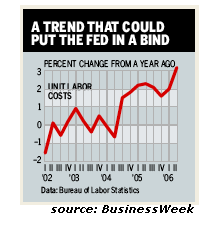 I have long held that the ultimate driver of inflation in the U.S. economy is not just energy
but medical/healthcare expenses, which constitute about 14% of the entire U.S. economy.
As costs in that sector rise far faster than overall inflation, the costs of benefits rises,
adding to inflation even as workers see less money in their (inflation-adjusted) paychecks.
Anyone who claims we are in a deflationary environment due to global wage arbitrage
(i.e. "made in China") should look at these numbers.
I have long held that the ultimate driver of inflation in the U.S. economy is not just energy
but medical/healthcare expenses, which constitute about 14% of the entire U.S. economy.
As costs in that sector rise far faster than overall inflation, the costs of benefits rises,
adding to inflation even as workers see less money in their (inflation-adjusted) paychecks.
Anyone who claims we are in a deflationary environment due to global wage arbitrage
(i.e. "made in China") should look at these numbers.
Lest you think I am exaggerating the inflationary potential of rising compensation, consider this
report from BusinessWeek.
August 14, 2006
A Thank-You to Readers
and
What About All Those Fixed-Rate Mortgages at Low Interest Rates?
 Sometime this weekend, this weblog logged its 250,000th visit of 2006. Thank you,
dear reader, for your readership and for your insightful comments and ideas. 250,000 visits
is no great shakes in a world in which a humorous video clip on youtube or Dr. Z over at
Chrysler garners millions of hits, but judging by the many knowledgeable, thought-provoking
emails I receive weekly from you, I would lay claim to having the most intelligent,
high-bandwidth, skeptical, independently minded and creative readers on the Web.
Sometime this weekend, this weblog logged its 250,000th visit of 2006. Thank you,
dear reader, for your readership and for your insightful comments and ideas. 250,000 visits
is no great shakes in a world in which a humorous video clip on youtube or Dr. Z over at
Chrysler garners millions of hits, but judging by the many knowledgeable, thought-provoking
emails I receive weekly from you, I would lay claim to having the most intelligent,
high-bandwidth, skeptical, independently minded and creative readers on the Web.
Though a quarter million visits may be no big deal to a commercial enterprise,
as a poor, dumb unknown writer, I am honored by your readership. When I started this
weblog (not a true blog, mind you, just a hand-coded variant) in May of 2005, my site
received perhaps 2,000 visits a month. Now it receives 15 - 20 times that.
More important than the statistics is you, the reader.
I am humbled by comments such as this one from Reader S.H.:
I just discovered your site a few weeks ago. How cool. I don't know how you write
intelligently on soooo many topics, but hey, you do. I start off each day reading your
entry. I've also learned a great deal from your writings. Keep up the great work.
P.S. I told my wife you'd be a great person to have as a next door neighbor.
I am grateful for S.H.'s readership, and can only say that I will strive to cover topics
worthy of your attention. Which means more or less everything....
Now on to today's topic!
What about all the people who didn't re-finance to the hilt or buy a home with an
adjustable rate mortgage? What about those who secured low-interest fixed-rate mortgages?
The housing bubble's demise will have no effect on them, so what's the big deal?
Good point. At first glance,
it would seem that the millions of homeowners who never re-financed at all, or who did so
only to lower their interest rate with a fixed-rate loan, not pull equity out of their
house, are utterly immune to the debilitating effects of the decline in current
housing values.
But beneath this apparently benign surface lies two forces which will affect
homeowners, even those with fixed-rate mortgages: property taxes and a declining economy.
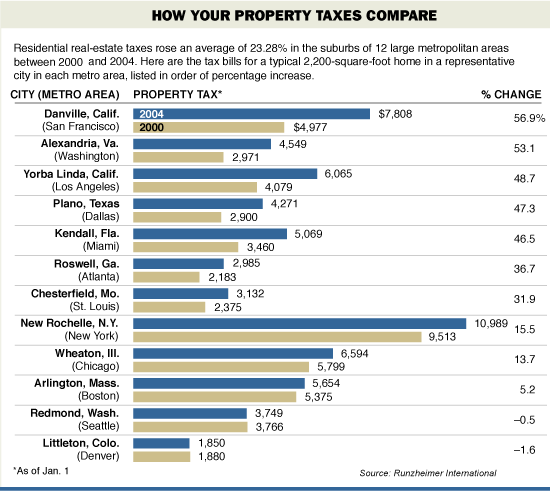
As you can see from this chart, significant property tax increases are being logged
practically across the board. Those living in states with with "Prop 13" limits (like California)
on how much existing property taxes can rise are protected, but some 35 states have no
such limits on increases. And while I haven't found any statistics on this, it is fair to
assume that waves of new county assessor's appraisals are washing over the land every month,
raising property taxes to recent bubblicious valuations.
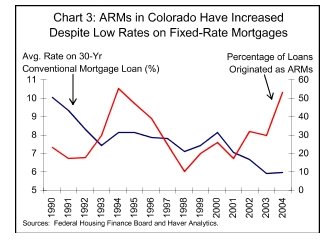 Here is a chart of an economy teetering on the edge of deep recession. Even if tens
of millions of prudent homeowners retained their fixed-rate mortgages and equity, millions
of other more desperate, profligate or deluded homeowners bought or re-financed with
adjustable rate mortgages which are already re-setting at much higher rates.
Here is a chart of an economy teetering on the edge of deep recession. Even if tens
of millions of prudent homeowners retained their fixed-rate mortgages and equity, millions
of other more desperate, profligate or deluded homeowners bought or re-financed with
adjustable rate mortgages which are already re-setting at much higher rates.
Buried within the many flavors of "exotic" loans lie uncounted quagmires. One of our
friends bought a house a few years ago on a fixed-rate (good) interest-only (not good) loan.
When the interest-only period expires in a year or so, then the payment jumps up not just
to start paying the principal, but a little extra to cover all that principal
which accrued during the interest-only "free ride" period. The jump in payments will be
truly staggering to anyone on a tight budget or non-yuppie income.
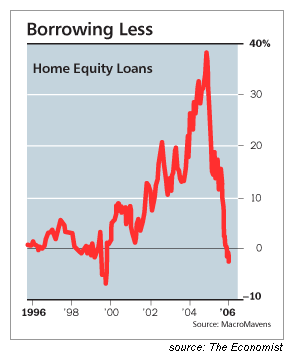 And as everyone knows, the stalling out or decline of real estate values has effectively
ended the re-finance gravy train. How many homeowners with the desire or need to pull
equity out of their homes have not already done so? And of those with the need, how many
have any equity left to draw out? Judging by the rapid fall-off in re-finance mortgage
applications, not many.
And as everyone knows, the stalling out or decline of real estate values has effectively
ended the re-finance gravy train. How many homeowners with the desire or need to pull
equity out of their homes have not already done so? And of those with the need, how many
have any equity left to draw out? Judging by the rapid fall-off in re-finance mortgage
applications, not many.
Bottom line: as all these millions of interest-only and adjustable-rate mortgages re-set
to much higher payments, millions of homeowners will have less to spend in the great
consumer economy which accounts for 70% of the entire U.S. economy. This means that
virtually everyone with a job or business,
regardless of their secure mortgages, will begin feeling the effects of the bubble's
consequences--the reduction in borrowing and spending which characterizes a recession.
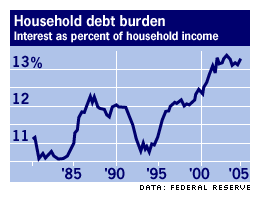 With household debt at record high levels (see chart) and U.S. savings rates at
rather infamously negative levels, there is no other ready source of borrowing or
pool of savings which can fuel further spending.
With household debt at record high levels (see chart) and U.S. savings rates at
rather infamously negative levels, there is no other ready source of borrowing or
pool of savings which can fuel further spending.
The sobering conclusion: while those with conventional fixed-rate mortgages are immune
to the direct ravages of declining housing values, they will still be negatively impacted by
the fall-out of the housing bubble:
rising property taxes and/or a recessionary economy which will cut into everything from
local government receipts to vendors to retail to you-name-it, even sectors and businesses
seemingly far from the housing/furnishing/lending sectors which are already suffering
declines in sales and employment.
Thanks to polymath reader Wayne D. for raising this topic some time ago.
August 12, 2006
False Confidence
 We found out our friend Steve Ng drowned in the Salmon River, in the Klamath National
Forest of Northern California. He was 35 and in excellent health. From what we can gather,
it seems he had gone snorkeling. The friend he was with (someone unknown to us) had swum on
ahead, and when he looked back, he saw no sign of Steve. After repeated dives failed to find him,
the friend drove off seeking help. So remote is this area that the Sheriff's office is
reportedly an hour's drive away.
We found out our friend Steve Ng drowned in the Salmon River, in the Klamath National
Forest of Northern California. He was 35 and in excellent health. From what we can gather,
it seems he had gone snorkeling. The friend he was with (someone unknown to us) had swum on
ahead, and when he looked back, he saw no sign of Steve. After repeated dives failed to find him,
the friend drove off seeking help. So remote is this area that the Sheriff's office is
reportedly an hour's drive away.
Although no one will ever know exactly what transpired in those few minutes, I suspect
Steve fell victim to a false confidence in his swimming and diving skills. Having paddled
around a reef-protected area in Hawaii with a mask and snorkel, he may have felt he was
experienced enough to swim/dive in a river. Sadly, he was unaware of the dangers specific
to rivers--strong currents, very cold (snow-melt) water, obstructions such as sunken branches,
slippery rocks, etc.
We suspect he went beneath the surface, allowing water to flow into the snorkel, which he
then inhaled. Without proper training and experience, he may well have panicked, sucking
more water into his lungs. I am not an experienced diver, but I do know you must always
retain enough air in your lungs to blow the snorkel clear of water
when you surface. Even this sort of very modest knowledge can save one's life, if you have
the presence of mind not to panic--a difficult thing to do when you're desperate to
breathe but cannot.
Unfortunately, I don't think Steve was very experienced in the water, and so his sense of
confidence was fatally misplaced. It is so very easy to feel this sort of false confidence,
especially when faced with potentially risky situations you don't even recognize as dangerous.
Examples abound: rock climbing, diving, body surfing, motorcycling, driving fast, working
on ladders, working with power saws, etc. But snorkeling in a calm shallow reef-sheltered
cove is not the same as braving the open ocean or fast-moving river water.
Several months ago Steve and I had taken a walk along Ocean Beach in San Francisco, after
lunch at an Islamic Chinese restaurant. Steve grew up in San Francisco, so I was surprised
when he asked me if I would go in the choppy surf that day. Ocean Beach has a notorious riptide--
incautious swimmers fall victim to it annually--and that day the sea was roiled by heavy,
choppy surf--very nasty even for a strong swimmer. Anyone in the water would be pounded
by wave after wave, with no break to reach calm water. I told him it was way
too dangerous to even think about entering. Thinking back, I realized he simply didn't know
how to judge the safety of the sea.
Having lived in Hawaii for so many years, I am respectful of the sea. I will not go in
heavy shore break (the kind that goes "wump!" when it crashes on the sand), expecially if
the bottom falls steeply away, as it does in certain stretches of Makaha and elsewhere. I
have read that life guards in Hawaii report the typical drowning victim is a male tourist in
his 40s or 50s, who undoubtedly recalls body-surfing as a teenager but who no longer has
the stamina for swimming in heavy surf. False confidence in the benign nature of the water
and in their own experience puts them literally in over their head. The same appears to be
true of those killed riding today's powerful breed of motorcycles: the middle-aged guy
who fondly recalls his Honda 90 takes his new bike out for a spin and finds, far too late,
that's its extraordinary power and acceleration is far beyond his control.
We all have our close calls; almost falling asleep at the wheel (another very easy way to die),
getting caught in an undertow or being pounded against the bottom by a big wave (or two),
ditching the bike when we missed a turn on gravel, almost slipping off a knife-edged trail, falling
off a roof, almost cutting off a finger or two, etc. etc. This is just a short list from
my own experience--no doubt you have your own list of close-calls. How many resulted from
false confidence, or faulty risk assessment? Almost all, I reckon.
My wife had seen Steve waiting to be picked up by his camping buddy, and she reported that
he was enthusiastically looking forward to the trip which would be his last on this Earth.
So what can any of us gain from such a senseless accidental death? Perhaps only a renewed
respect for the fatal potential of any body of water, and a renewed appreciation for the
limits of our own experience, skill and endurance.
August 10, 2006
Our Major Export to China: Inflation
Yesterday's entry, "Chasing Our Tails," on the standard-issue pundit claim that corporate spending
will replace consumer spending as the consumer runs out of disposable cash/credit,
drew this insightful response from knowledgeable
correspondent Harun Ibrahim: (emphasis in bold is mine)
I've been asking the same question ever since that clap trap
was uttered but no one in that camp seems to have an adequate answer. That
tells me that people are in hope mode.
Hope is deadly to an equity curve.
Once again if you refer to the Excel spreadsheet of the SP 500 (CHS: the COT data) and look at
the commercials, non-commercials, and non-reportable traders you will notice
that though the Bulls are strong in their rhetoric their positions are not
when compared to the height of the secular bull market. However, open
interest is at record levels. In short, mid-1995 commercials began
liquidation of net long positions well ahead of the peak in prices and went
net short, the public went net long. 2000 the market declined until late
2002 destroying the paper profits of the public. From late 2002 until
present the market rallied and tested old highs. The commercials are still
net short and the public is still net long. Clearly a divergence is in
effect; technical indicators such as MACD and DMI bear this out.

The public must learn there are fundamentals and there is the game.
As for grains, in my last missive I was not giving a tip about soybeans
because I don't give tips. What I was trying to point out is that the masses
are looking in the wrong direction. Gold, equities, currencies and oil seem
to be the talk of the day and they should be to a point. Doesn't the
industrial revolution in China mean that they will likely consume more
agricultural products as well? What effect has the heat wave had on grain
crops? Why are commercial traders so bullish in soybeans? Why is the public
so bearish? Why are Large traders (trend following funds) sitting on the
fence. Who has the most knowledge and information about grain supply and
demand, the general public or General Mills (producers and/or processors)?
More basically, how do bonds, stocks and commodities move relatively in
economic cycles? Is this relationship consistent enough to be historically
significant? And, where are we now in that cycle? How will risk be managed?
Correct answers come from asking the correct questions.
I recommend to you if you have not already read it,
Reminiscences of a Stock Operator by Edwin LeFervre. Published in 1923. It is timeless.
by Edwin LeFervre. Published in 1923. It is timeless.
Harun then added:
The COT is not the holy grail but it is a tool. Market cycles occur because it is
apparent from history that human behavior is cyclical. Are cycles perfect in
repetition? No, there is phase and jitter.
In trying to give permanent ups and no downs the Fed and all central banks
are experimenting with forces they don't understand. Therefore the Fed's
mission was doomed the moment it was conceived.
Bernanke studied every detail of the Great Depression. I have no doubt that
his knowledge of it is deep. I also have no doubt that because of the way he
studied he has completely missed the point.
No individual or group will ever succeed in removing fear, greed, euphoria
and depression from the human psyche.
A couple of my favorites aphorisms:
"Not everything that counts can be counted, and not everything that can be
counted counts." (Sign hanging in Einstein's office at Princeton)
"As far as the laws of mathematics refer to reality, they are not certain,
as far as they are certain, they do not refer to reality." --Einstein
Excellent commentary, Harun--thank you.
Building on Harun's comments on China's rising demand for commodities, let's consider
this chart:
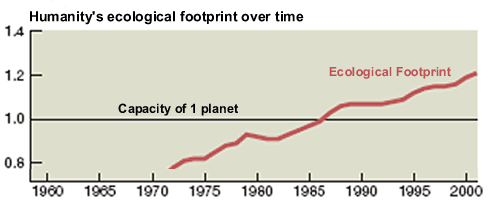
The question posed by the chart is obvious: is there enough oil, copper, gold, soybeans
and water to feed China's 1 billion hungry consumers? The answer, I think, resides in the
chapter on China in this seminal book by E.O. Wilson,
The Future of Life .
The short answer is: no, there are not enough resources to support another billion people
in a profligate American-style consumerist lifestyle. Before you protest, read the book. .
The short answer is: no, there are not enough resources to support another billion people
in a profligate American-style consumerist lifestyle. Before you protest, read the book.
Now let's turn to our primary export to China: inflation. Have you ever read anything
in the financial media which asks this question: if the value of the U.S. dollar has fallen
by almost 50% since 2002 (see chart in yesterday's entry), what happens to countries which
have pegged their currency to the dollar--like, for instance, China?
Funny, I've never read an exploration of that question, either. Yet the answer is rather
obvious, isn't it? Everything imported costs more for them just as it does for us.
And what does China import in vast quantities? Commodities: oil, cement, soybeans, rice,
wheat, copper, etc. Oil, of course, is currently priced in dollars, so the Chinese pay no
premium for the dollar's recent devaluation. But if the oil exporters ever decide to price oil in
non-dollar currencies, the cost of oil in both the U.S. and China
would skyrocket.
And not all commodities are priced in dollars. Certainly, the high-tech machinery and
equipment which China imports from Japan and the E.U. is 40% higher than it was in 2002--or
the Japanese and E.U. exporters are getting 40% less if they've kept the price the same
as in 2002.
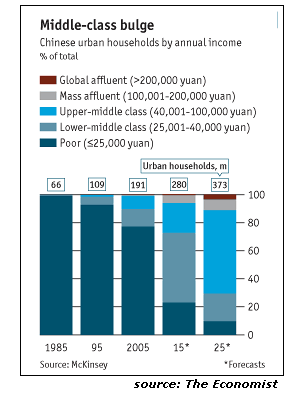 Let's be clear on this: either China pays much more for imported goods because of the
dollar devaluation, or those exporting to China are making far less profit--if any.
The rah-rah standard line of China-related euphoria is encapsulated in this chart from
The Economist's article
Ready for warfare in the aisles (Retail trade in China).
Let's be clear on this: either China pays much more for imported goods because of the
dollar devaluation, or those exporting to China are making far less profit--if any.
The rah-rah standard line of China-related euphoria is encapsulated in this chart from
The Economist's article
Ready for warfare in the aisles (Retail trade in China).
The standard line is: China's middle class is growing rapidly, and retailers will be
able to charge enough for both imported and domestic goods to make a tidy profit.
But rising inflation in China casts some doubt on that; as recently chronicled here
(please see articles on China in the right sidebar), typical factory wages are about $60 -
$85 a month--about $1,000 a year. Farmers in the vast hinterland make much less.
There is another fly in this "rah-rah retail paradise" ointment: high prices. Even though the vast
majority of people are very poor, things are not cheap in China.
Having traveled in China recently, and in Thailand and Japan as well, I can
report that goods are not cheap in China. Standard items like cotton T-shirts and
street-vendor meals are cheaper in Thailand--and we're not even talking about medical care
or real estate. When I first visited China in 2000, rather ordinary condominium apartments
in Suzhou (an hour west of Shanghai) could be had for about $40,000. (In China, the condos
are just concrete shells with plumbing and electrical stub-outs; the new owner has to add
the interior walls, flooring, ceilings, cabinetry, plumbing and electrical fixtures, etc.)
Now the exchange rate is about 8 yuan to the dollar. The Economist pegs
40,000 yuan per year as a middle-class benchmark, which translates into about $5,000. Upper-middle
class income is thus about $10,000 annually. So back in 2000, a lower-middle class family
could buy a simple apartment for about 10 times their annual income, while their better-off
brethren would only require about 5 times income.
That upper-middle class, of course, is a relatively small sliver of the population.
(10 million out of 1.2 billion). So what's that
condo selling for now? Try $150,000 - $200,000. That's dollars, not yuan. So even the
upper-middle class household now has to pay 20 times their annual income to buy an
apartment in a secondary city--clearly impossible. Wages in China have only recently
begun to rise; like wages in the U.S., they have not kept pace with inflation.
So what is the net result? Rising demand and a falling dollar have boosted the prices for
commodities and imported goods, creating a rampant (if officially unreported) inflation which hits all
Chinese consumers equally hard. Real estate (yes, we exported our housing bubble to China, via our
flood of dollars) and medical care are unaffordable to the vast majority of Chinese
households.
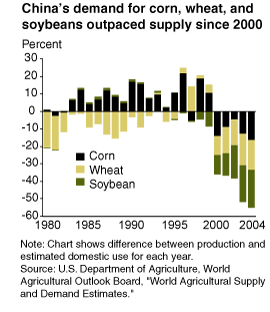 As the dollar has plummeted, creating inflation and decimating E.U. and Japanese exporters' margins,
who's made money? Retailers? I think not. While the chart above suggests that the
rise of the Chinese middle class is a mighty inexorable wave, it neglects to mention that
inflation and a bubble in housing has rendered their "middle-class" income not very middling.
The notion that the average "middle-class" household with an income of $5,000 - $10,000
a year is able to spend lavishly on consumer goods even as inflation and rising commodity
prices diminish their purchasing power--skepticism is again in order. And what about the
workers who make $1,000 a year?
As the dollar has plummeted, creating inflation and decimating E.U. and Japanese exporters' margins,
who's made money? Retailers? I think not. While the chart above suggests that the
rise of the Chinese middle class is a mighty inexorable wave, it neglects to mention that
inflation and a bubble in housing has rendered their "middle-class" income not very middling.
The notion that the average "middle-class" household with an income of $5,000 - $10,000
a year is able to spend lavishly on consumer goods even as inflation and rising commodity
prices diminish their purchasing power--skepticism is again in order. And what about the
workers who make $1,000 a year?
Lastly, let's speculate on what may happen to commodity prices if crop failures, or
oil supply disruptions, or a big decline in the dollar occur. Just to give you a taste: the average
middle-class American family spends about 5% of its household income on food. The average
Chinese household spends 40% - 60% of household income on food. A similar imbalance
exists in the relative weight of oil costs. What is a trivial amount to an American (gasoline
is perhaps 3% of household income) is a heavy burden to a typical Chinese household.
The upshot? Don't bet the farm on how fabulously profitable retailers will be in China.
August 9, 2006
Chasing Our Tails?
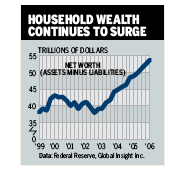 As the U.S. economy and consumer spending weakens, "the usual suspects/pundits" are
unanimous in their prediction that corporate spending will take up the slack. Nice theory,
but doesn't corporate growth depend on consumer spending, which is roughly 70% of the entire U.S.
economy? And if consumer spending is faltering as the real estate bubble house-of-cards
collapses, then exactly why would businesses ramp up their spending?
As the U.S. economy and consumer spending weakens, "the usual suspects/pundits" are
unanimous in their prediction that corporate spending will take up the slack. Nice theory,
but doesn't corporate growth depend on consumer spending, which is roughly 70% of the entire U.S.
economy? And if consumer spending is faltering as the real estate bubble house-of-cards
collapses, then exactly why would businesses ramp up their spending?
The Bull case is enshrined in this little chart: we're all richer now, much richer, so
we can continue to spend, spend, spend. But there's a few things wrong with this
glowingly Bullish chart:
1. The rise in wealth coincides with the rapid run-up in home values and the stock and
bond markets since 2002. Now that the stock market is due for a fall, bonds are iffy and
housing is falling, then what makes anyone think the wealth will continue rising?
 2. Most of the stock and bond wealth is held by the top 10% of U.S. households. Hence, this
vast rise in wealth is not evenly distributed among the consuming millions; it is only
available to the top layer of wealthy families.
Wealthiest American Families Add To Their Share of U.S. Net Worth:
2. Most of the stock and bond wealth is held by the top 10% of U.S. households. Hence, this
vast rise in wealth is not evenly distributed among the consuming millions; it is only
available to the top layer of wealthy families.
Wealthiest American Families Add To Their Share of U.S. Net Worth:
The top 1% held 33.4% of the nation's net worth in 2004, up from 32.7% in 2001, but still
lower than a peak of 34.6% in 1995.
In 2004, the wealthiest percent owned 70% of bonds, 51% of stocks and 62.3% of business
assets.
After the richest 1%, the Fed found that the next wealthiest 9% of families held 36.1% of
net worth in 2004, down from 37.1% in 2001. Below them, families in the top 50% to 90% held
27.9% of net worth in 2004, a slight increase from 2001, while families in the bottom half
saw their share fall to 2.5% of net worth in 2004 from 2.8% in 2001.
Sounds like chasing our own tails is the key the future U.S. economic growth:
consumers are supposed to keep spending even as interest rates and energy costs rise,
as employment softens, as wages continue to fall behind inflation and as the rise in home
equity which enabled the borrowing of trillions in "free money" dries up. And if they falter, then hey,
businesses will pick up the slack. But don't businesses sell to consumers? Last time
I looked, they did; and if your customers are spending less, why would you choose to invest
heavily in new plant and equipment?
The standard answer is "greater efficiency," but isn't there a law of diminishing returns
as all the low-hanging fruit of productivity gains have been reaped? Why dump billions in
new software and equipment in the U.S. when your domestic sales and profits will be dropping?
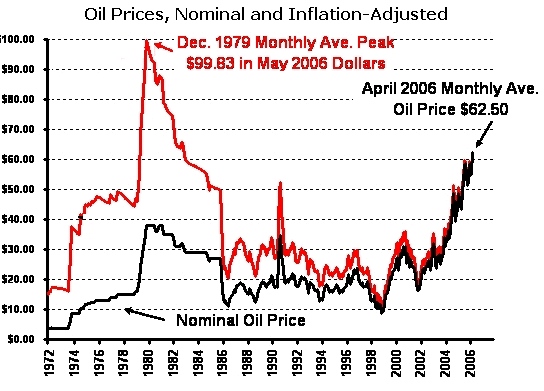
That U.S. corporations have hoarded their unprecedented profits for years, restraining
their investment in new plant, has been a conundrum to many; but isn't it rather obvious
that corporate managers are voting with their pocketbooks for a slowdown/recession? The
restrained spending suggests that the corporate leaders weren't fooled by the "prosperity"
of the past five years, and that they saw no reason to build new domestic capacity when an inevitable
recession loomed ahead.
Forget Mideast: Profits Are the Problem:
Standard & Poor's also expects earnings to continue growing at a double-digit pace in the
second half of the year. If those forecasts hold, it would make for the longest stretch of
double-digit earnings gains since 1950, surpassing a long string of gains in the early
1990s.
Profits surge to 40-year high(marketwatch.com):
U.S. corporate profits jumped 21.3 percent in 2005 to $1.35 trillion. Profits have been
boosted by strong productivity gains and low wage growth, and now account for their largest
share of national income in 40 years -- 11.6 percent. The share that went to wage and salary
earners, however, sank to 56.9 percent in the fourth quarter -- nearly a 40-year low. "It's a
big puzzle," said economist Josh Bivens of the Economic Policy Institute. "If this is a
knowledge economy, how come the brains aren't being compensated?"
Maybe corporate leaders saw what is obvious in these charts: a sinking dollar which
will eventually squeeze consumers with higher import prices; rising energy costs reducing
their discretionary spending; and a frightening reliance on massive home equity extraction to
support their spending.
U.S. News and World Report:
Home building has accounted for about a quarter of the jobs created since the 2001 recession.
In the past five years, housing has also provided about $2.5 trillion in cash for owners
refinancing through home equity loans ($751 billion last year, twice the high point reached
in the late 1980s).
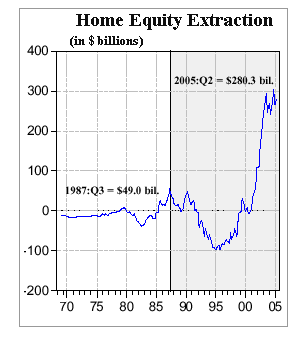 If this is "healthy growth," then why didn't companies spend on
new expansion? Answer: because it was obviously a bogus prosperity all along, built entirely
on the housing bubble, massive expansion of low-cost credit and low energy costs. Now that
all those conditions are disappearing, so is the "prosperity" which rested on such a castle
of sand.
If this is "healthy growth," then why didn't companies spend on
new expansion? Answer: because it was obviously a bogus prosperity all along, built entirely
on the housing bubble, massive expansion of low-cost credit and low energy costs. Now that
all those conditions are disappearing, so is the "prosperity" which rested on such a castle
of sand.
But wait, say the pundits: the dropping dollar will boost exports. Maybe, and how
convenient that will be for their theory of rising coporate spending. But the truth is
U.S. exports are heavily weighted to just a sliver of sectors: agriculture, aviation,
software, entertainment. Just as the supposed "wealth effect" is actually concentrated in
just a few hands, so too will rising exports be concentrated in a few hands. And what
if demand in China, India, et. al. keeps oil prices rising? Then any increase in exports
will simply offset the continued rising costs of petroleum imports.
Relying on business spending to compensate for a flagging consumer is a threadbare
rationalization of rah-rah cheerleaders hoping to convince the public that the aging Bull
market is actually a young'un with years of vigor ahead. Skepticism is in order.
August 8, 2006
Climate Change, Grain and Energy
Polymath correspondent Albert T. has yet again alerted us to a little-noticed but
profound long-range issue: dropping grain yields in a world of growing demand.
(Emphasis in bold is mine. Note that even though soybeans are legumes, they are
included in grain trade statistics.)

Went to one of my favorite sites www.world-grain.com. I got into it after reading this book last
year, Merchants of Grain. Great book, very good read.
(CHS: Here is the link to buy the book on Amazon.com if your library doesn't have a copy:
Merchants of Grain ) )
Russia's grain exports could total 7-mln tons this year (world-grain.com)
Black Sea Region Wheat Exports to Drop by Half (usda.gov)
AUSTRALIAN WHEAT HARVEST SET TO FALL IN 2006 (world-grain.com)
Short Crops Reduce Argentine Grain Exports (usda.gov)
This got me thinking about tulips and Netherlands. Agrarian dependancy of one country on
others like China depending on Thailand and others to make up rice shortfalls at home.
Also market efficiency is coming into question as price flexability erodes. All these
institutions to create a streamlined monopoly to bargain in the world like AWB, CWB, etc...
The correlation between transport costs and grain has something to do with it going higher
as well as the ethanol craze sucking up supply. But all this combined with the overall lower
supply by major producers is interesting. True all are acting on their best interests, what
is also true this is drifting into an economic setup where a food squeeze might occur given
the right conditions. Someone would eventually use it as a leverage tool somewhere.
Indeed, according to Merchants of Grain, the U.S. administration considered halting
grain shipments to the U.S.S.R. in 1975 for political leverage. (By the way, I also
recommend the book, hence the link to amazon.com.)
Continuing our exploration of the topic, we find that the U.S.D.A.'s (U.S. Department of
Agriculture) long-range outlooks don't really address the potential for climate change.
Wheat: Market Outlook (USDA Economic Outlook Service)
One school of thought suggests that rising CO-2 levels may actually act as an
atmospheric fertilizer, enhancing crops yields; but this USDA study casts doubt on that
scenario:
New Crop-Yield Study Casts Doubt on a Climate-Change Prediction
These long-term estimates don't seem to reflect the potential for
substantially higher demand in China as the hunger for grain-fed meat rises along with
incomes:
China's Demand for Commodities Outpacing Supply
The forecasts also neglect the possibility of sharply higher demand for corn and other
feedstocks for ethanol, if oil prices continue rising:
Ethanol Reshapes the Corn Market
And lastly, there is virtually no mention of the widespread, seemingly unprecedented
number of droughts which are afflicting primary grain-growing regions such as Australia
and the American Midwest. These omissions seem glaring, to say the least.
Thank you, Albert, for bringing this critical issue to our attention.
August 7, 2006
Post-Bubble Nightmares
Could the housing bubble's burst create not just a self-reinforcing feedback loop of homeowner and lender financial losses,
but a series of inter-related negative feedback loops of demographics, job losses
and decaying neighborhoods? Here are some readers' thoughts on the matter.
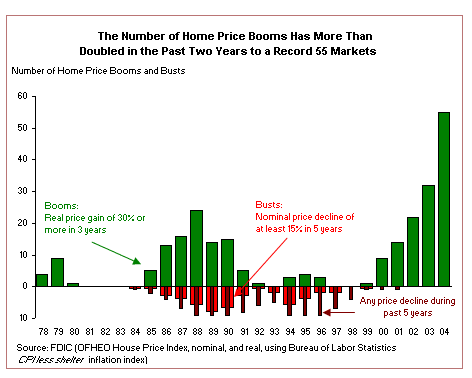
Astute reader Scott in PA noted the out-migration from states
suffering from job losses in traditional manufacturing to
locales which temporarily created a surplus of housing-related jobs.
(Scott modestly noted, "I am not an economist and have no claim to expertise," but
I think he's hit on a very important topic: how the rapid rise in housing
prices has not only distorted the nation's capital allocation, it has also
caused people to move to red-hot housing areas which may well begin
losing this recent population growth as housing-related jobs disappear:
One thought regarding your recent posting and the reader-provided graph at
the end on non-traditional mortgage products.
I looked at the states in the lower left and noted that many
of them are losing population. Maybe the housing
bubble had even larger implications for the U.S. than just the
'pseudo' runup in the GDP. As it has been widely argued, the
U.S. economy since the dot.com burst has been stagnant or
contracting, and the only industry with growth has been construction
spurred by the Greenspan-era Fed 's liquidity; as a result, these growth
hotspots created
a suction effect on people/money. These mini-vorteces in hot
urban or retirement locales have been pulling humanity away from more
conventional communities, and thus down the drain. It seems as if
the drains are now plugged up, soon to create concentrated
nightmares. At least during the Dust Bowl era there was room for
interstate migrants and they could be absorbed by other states.
So, this liquidity created a false economy which was localized,
as the chart shows, and which encouraged population shifts as
a temporarily flush construction business created jobs in some places
along with a need to leave because traditional manufacturing
jobs (and R&D) were dying.
States with high housing costs are also losing population, or at least those sectors
of the population with children. As my esteemed colleague over at the
Marin Real Estate Bubble has recently noted, California is losing population not
from a contraction of manufacturing but from the absurdly unaffordable cost of housing.
Families with children are leaving the state in droves, causing an outright decline in the
number of school children even as the state's total population increases.
My colleague at the Marin Real Estate Bubble also sent over an eye-opening article which
details how the Federal Reserve created the bubble by
lowering lending reserves to basically zero, enabling lenders to write hundreds of
billions in new loans with virtually no actual cash reserves to speak of. Read this and
wonder no more how the Fed engineered such a massive flood of equity out of thin air.
Several readers provided compelling scenarios on how foreclosures, bankruptcies
and the decay of neighborhoods could play out. Here is a fascinating account from
our correspondent David, who experienced the last boom-bust cycle in housing:
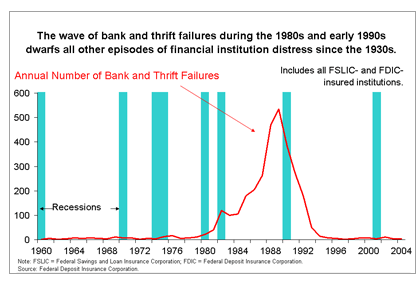
I have the answer to your "Another knowledgeable reader suggested that
people might well stay in their homes regardless of foreclosure
proceedings:" question.
While in college in the early 1980's I lived in a housing complex that went
into foreclosure. The mortgage holder also went bankrupt. For years the
property was passed around to 'failing' mortgage companies. We never paid
rent as we didn't have any idea where to send a check! I assume that it was
such a mess that no one sent out eviction notices - partly because we were
tenants and would pay, so I guess no one wanted to kick us out but no one
ever 'owned' the property long enough to send out notices about where to
send the rent payment.
It was total chaos but I lived in a very nice duplex for 3 years rent free!
We even setup a defacto 'home association' to make rules and fix problems
(it was a complex of several hundred duplexes).
My U.K. correspondent described how the lack of maintenance associated with squatters
might well add to the deterioration of hollowed-out/decaying neighborhoods:
One of your correspondents said:
"Overall this additional stickiness will prohibit the price curve of housing from tracking
the price curve of liquid, unsticky assets as your thesis asserts. It would also argue
against wholesale "suburb death" for strictly reasons of foreclosures of occupied properties.
My feeling is that, at best, this effect might delay the inevitable a bit and could even
accellerate the death spiral. You mentioned a number of reasons why the decline would
continue and I would add one more. Squatters will not look after a property - they will
not invest a nickel in repairs or maintenance. Why should they? It not their property
and they are likely to be broke, bitter or both. It's likely that houses held by squatters
would degrade faster than properties standing empty.
If the squatters are really "sticky" then getting them out will incur costs. If the lenders
think that the resale value in an area isn't going to cover the eviction expenses they will
just give up, write it off, and decide to concentrate their efforts elsewhere. Houses in
the declining areas could then rarely be available for sale and if even they were, who
then would buy a dilapidated property in an area surrounded by equally dilapidated
properties? In conditions of oversupply, if you have the money to make a purchase,
you can go elsewhere. If you don't have the money, you can squat in an empty one for free.
Possibly the declining suburbs will not be empty. Until the properties become uninhabitable,
they could be fully populated with people that have nowhere else to go. It does not matter
if the people were always in residence or simply just moved in and took over. The
neighbourhood will increasingly become a very not-nice place to be and the properties in
the area will have an essentially zero resale value.
I'd say there was a case for the theory that an area could well become uninhabitable sooner
with a population of squatters than it would do if the houses were empty.
This sounds like a very grim but entirely plausible scenario, especially in areas
whose growth was largely dependent on housing construction, lending and services. As those
jobs dry up and blow away, there will not be enough other jobs in these local economies to
support the huge influx of recent residents. If this isn't a nightmare scenario, it's pretty
close. Thank you, readers, for such thoughtful comments.
On a personal note: I was deeply distressed to learn last Friday that my friend and neighbor
Steve Ng was accidentally killed while on a camping trip in Northern California. The county
sheriff's office explained that they were unable to provide any details of the accident
until they have notified the next of kin. Steve was just 35, and in the process of finally
obtaining his 4-year college degree. He was full of life and promise, and his sudden death
has shocked and saddened his neighbors and friends.
* * *
We have a winner! Reader D.A. correctly identified Friday's mystery location as Storm
Point, Yellowstone Lake, Yellowstone National Park, Wyoming. (There is a 455-acre lake in Wisconsin called
Yellowstone Lake, but this one covers 136 square miles and is the largest fresh-water
lake in the world over 7,000 feet in elevation.) A copy of my novel I-State Lines goes out to
D.A. for his correct answer. Thanks to everyone who sent in a guess!
August 5, 2006
Post-Bubble Exurbia: Flint, Michigan?
Readers have added a number of scenarios to
Twilight for Exurbia?, which proposed that commute-Hell exurban communities
might suffer near-abandonment in the post-bubble housing decline. The entry included
a link to an aerial photo of a hollowed-out Detroit neighborhood as an example of
what can happen when jobs and people leave an area.
First up is an astonishing description of Flint, MI by correspondent A.L.:
(Note to residents of Flint: this is not a knock on your town; most people just
don't know how devastating it is when the Company leaves a Company Town; I lived
in a Company Town, so I know):
I spent a bit of time in Flint MI and saw your example of hollowed out
neighborhoods first hand.
The overhead view gives no concept of the depth of decay. It's as if the
world ended and you are on a post-apocalyptic anthropological
observation tour. Trees have regrown through what once were houses, and
the undergrowth has filled in the margins of civilized infrastructure.
Here and there one can see signs of structure, the odd driveway, or
fireplace brick. But for the most part it's literally a jungle, filled
with wild animals and the occasional human. There are whole square block
sections that are impassable by automobile, and seem bound to return to
complete wilderness someday.
The law of the jungle applies here, the Flint police department is a
shriveled husk of its former glory. Why bother to patrol the empty
wastelands at all?
My friend who was working for GM Engineering has since been transfered
to Ann Arbor, and it's a veritable wonderland, being a college town an
all. He's ridden the real estate rollercoaster as well, but he's a
fiscally ultraconservative and is happily ensconced in his cheapo 50s
ranch house that he bought 10 years ago.
What housing-related factors can we take away from this account?
How about:
Areas which are heavily dependent on a single industry (in Flint's case, automobiles
manufactured by General Motors) are especially vulnerable to abandonment should
that industry falter.
Which raises an interesting question: what if the primary industry in an area is
housing itself?
Locales with established government-supported institutions such as large universities
will be much less likely to suffer a community-destroying loss of residents.
Another knowledgeable reader suggested that people might well stay in their homes regardless
of foreclosure proceedings:
What you and your other reader are assuming is that persons foreclosed upon will behave
rationally and give up the asset. I would submit to you that for owner occupied properties,
a large proportion of foreclosed owners will remain as squatters. There will be very
little appetite in the U.S. for evening news photos of large scale forced evictions, and as
banks are faced with increasing inventories of foreclosed properties in "management"
little interest in actually evicting the ex-owners.
Where are those foreclosed owners going to go? Unless there is a major change in how
apartments and most landlords of SFH (single family home) make decisions on tenant selection, few will take
the risk of renting to someone with a recent foreclosure on their credit history. In
this scenario, where traditional re-housing in rented accommodations is
difficult/expensive/impossible, it's move home to your parents (or other relatives),
a Hooverville, or stay in place and wait for the forced eviction. My guess is most
will choose to squat, particularly as banks get distracted by the sheer volume of foreclosed
properties.
Overall this additional stickiness will prohibit the price curve of housing from tracking
the price curve of liquid, unsticky assets as your thesis asserts. It would also argue
against wholesale "suburb death" for strictly reasons of foreclosures of occupied properties.
This reader brings up a number of important issues. Sheriffs forcibly evicting former
homeowners from their houses may well have unforeseen political consequences. But I also
see five other factors in this scenario:
Areas with large numbers of "speculator/flipper" property owners may not have enough
actual residents to create a neighborhood people want to stay in.
Banks may try to escape the "squatter" problem by selling distressed properties for
peanuts to private investors, who will then take individual, less-visible/newsworthy
actions against the former owners/current squatters: quiet evictions, cash pay-offs to move,
negotiations for some kind of rent, etc.
People's decision to move or stay put will largely hinge on their income. If they have
lost their job or the majority of their income, they will have no choice but to move in
with family or friends or a Hooverville (encampment of the unemployed, named after the
President who waited for "market forces" to resolve the Great Depression.)
The reason? Even if they're squatting, they will need money for food, gasoline, heat, etc.
So in other words, if a two-worker household loses one job, squatting makes financial
sense. But if both wage earners lose their jobs, or a single-earner household loses its sole
source of income, people will have every incentive to move in with family once their
unemployment runs out.
In a recessionary environment, landlords may well be less picky about the credit history
of tenants. I suspect that many landlords will be more interested in prospective tenants'
income than in their credit history--especially if said landlord is sitting on lots of
vacant units. Some landlords may well be counting on rents to stave off
their own bankruptcy/foreclosure, and that will also make them less sensitive to issues
such as credit histories. Lastly, experienced landlords can tell the difference between
evictions for non-payment (a bad risk) and bankruptcy/foreclosure (maybe a risk, but
maybe not; in a recession, lots of people lose their homes and that doesn't necessarily
mean they will be bad tenants.)
This brings up another question: if thousands of single-family houses are sold at
auction, then how much money will the new owner have to charge in rent
to pay the mortgage (if any), property taxes, maintenance, etc.? If a house which once sold
for $300,000 is sold at auction for $100,000, the new owner may well be happy to collect
a relatively modest amount of rent because his/her expenses are so low.
(Note that for
desperate lenders sagging under huge numbers of non-performing loans, a $100,000 cash offer
is far more attractive than a $200,000 offer with $20,000 down and a new loan of $180,000.
The reason is that the lender's cash reserves against bad debt--the reserves which are
mandated by regulatory agencies--will be a negative number, so cash is what they need, not
a new loan.)
The decision to squat or leave may well depend on the shoddiness of the construction and
the safety of the neighborhood. If hastily built subdivisions start falling
apart (leaky roofs, leaky, mildew-infested plumbing, electrical wiring issues, etc.), people
may prefer the dry safety of their in-law's garage. Also, if neighborhoods attract
unsavory types of squatters as well as the recently dispossessed, the neighborhood could
quickly become an unsafe, dangerous haven for the predatory wolves in our society.
At that point, decent people will move out, regardless of any other issue.
Astute reader D.F. provided another answer to the question,
"where might oversupply lead to outright abandonment of recently built homes?"
and a chart to back up this scenario:
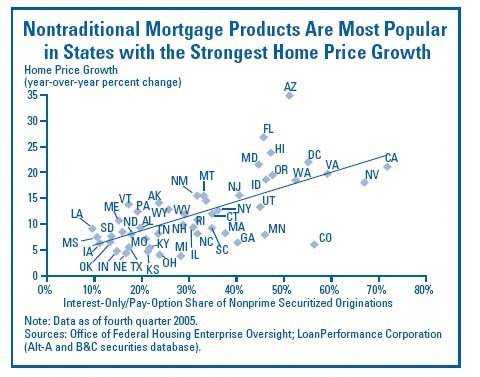
I predict that we will see entire neighborhoods, even in major metropolitan areas, that
were built near the end of the housing bubble (2004-2006), where the majority of people
put down pre-construction deposits and took out interest-only or ARMs loans and put very
little, if any, $$$$ down. I would look at Florida (Miami, Ft. Lauderdale, Tampa),
California, DC, Vegas, Phoenix, Seattle, etc.
Thank you, readers, for these thought-provoking comments on an important subject.
August 4, 2006
Our New Sponsor: Ronald Dump, Entrepreneur
and... Friday Quiz: Where Is This?
Please welcome this site's latest sponsor: Ronald
Dump, entrepreneur extraordinaire. Readers already know that our short list of
site sponsors includes
ads by groogle, Kroika! Cookies,
Jank Coffee, Astra-Zastra Pharmaceuticals and Cervantes Beer; joining this high-powered list of hot international brands
is Ronald Dump, multimedia maven and inspirational speaker to hordes of wealth-craving
wannabes. I am sure you'll want to learn his latest secrets on entrepreneural success
in the New America and the New Global Economy:
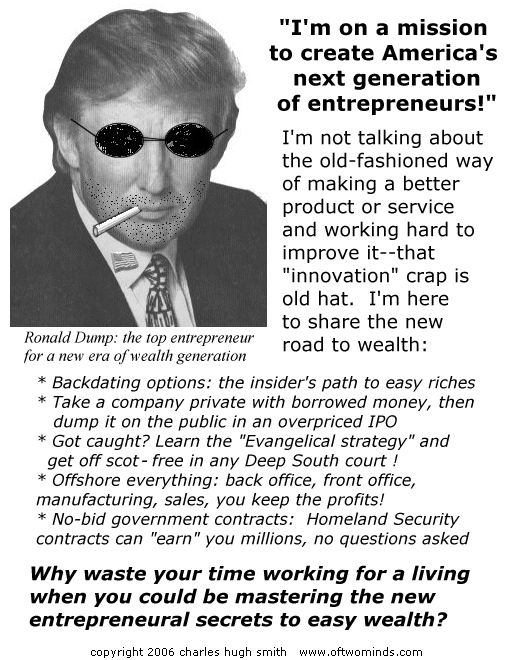
Now that you've welcomed Ronald Dump to the fold: where do you reckon this is?
Be the first to identify this specific spot, and I'll send you a collector's copy of my book
I-State Lines.
So email me!

A big "mahalo plenty" to Strawgold for her kind permission to use this wonderful photo.
To give you a very general clue about the region in the country where our stunning
mystery lake is located, here is a story from I-State Lines:
Showdown
"Despite the fact I know Alex will inevitably get us in griff up to our chins, I am always surprised when we
step into it. It always looks so peaceful, like what could go wrong here?"
You can get I-State Lines
from my favorite online independent bookstore,
The Kaleidoscope: Our Focus Is You
(Shipping is free on all orders).
Or if you have an open order at amazon.com, you can of course add
I-State Lines to it for $13 (orders over $25 ship free), which is less than the camping fee to
certain parks (hint hint). And I-State Lines is light enough to fit in any backpack.
to it for $13 (orders over $25 ship free), which is less than the camping fee to
certain parks (hint hint). And I-State Lines is light enough to fit in any backpack.
Secrets to Building A Brilliant Brand!
ads by Groogle
August 3, 2006
The Dollar and the Price of Oil
Is there any connection between the value of the dollar and the price of oil?
Let's look at a monthly chart of the dollar index over the past 8 years.
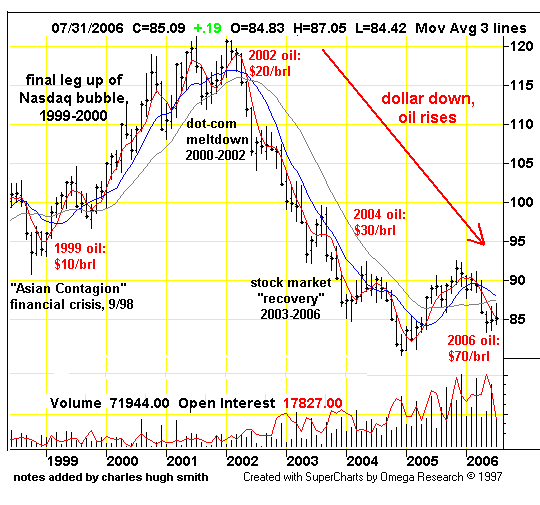
Recall that the global market for oil is made in dollars. That is, when exporting
nations sell their oil, they receive dollars in exchange for their oil. While there
has been some movement in Iran and Venezuela to create a market for oil in euros, the
reality is that oil is still priced in dollars. Thus, the value of the dollar relative to
a basket of other currencies is of great interest to oil exporting nations. And the
cost of oil in dollars is of great interest to us residents of the U.S., who cannot
count on currency appreciation to offset the rising price of oil.
(NOTE: For instance: a euro fetched 90 cents in 2002. It now fetches $1.20 -- about 33% percent more.
But since oil is priced in dollars, holders of euros enjoyed a 33% decline in the
cost of oil in that timeframe. So even though oil has more than doubled in dollars,
it has risen considerably less in euros due to the sharp devaluation of the dollar/appreciation
of the euro.)
A good place to start is the "Asian Contagion" financial crisis of Fall 1998, which included
Russian bond defaults and the Long Term Capital Management derivatives debacle. As most
Asian economies stumbled under the onslaught of currency devaluations and general recession,
the price of oil dropped along with demand. Oil exporting nations, loathe to lose income,
kept the supply well above the reduced demand. The net result: the price of oil collapsed to
$10/barrel.
As the U.S. economy pulled the rest of the global economy out of the hole, the dollar
gained and the price of oil recovered, reaching $20 in 2002. Even the dot-com meltdown didn't
curtail global or even American demand for oil, but the dollar's rise gave the oil exporting
nations another nice boost. Not only were they getting more money for each barrel, they
were getting more value for the dollars they received in payment: about 30% more value
as the dollar climbed from 95 to 120.
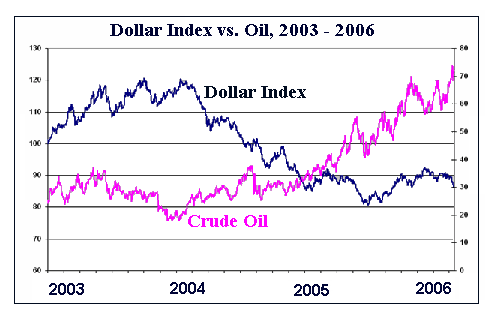
But then the dollar began a long decline. Oil exporters received a hefty 50% nominal
gain in the price of oil--from $20 in 2002 to $30 in 2004-but they also received a 33%
haircut in the value of the dollar. Net result: their big gain was largely eviscerated
by the decline in the dollar.
That's why I placed the U.S. stock market "recovery" in quotations marks. If you were a foreign
holder of U.S. stocks, the "recovery" wasn't that great, as the 50% rise in U.S. stocks
was largely offset by the 30% decline in the value of the dollar.
As the dollar approached 80 in 2005, oil exporters were suffering from a nearly 50% decline in the purchasing
power of the money received for their oil. In a fortuitous coincidence, rising
demand and constrained supply raised the price of oil from $30 to $70, more than offsetting
the decline in the value of the dollar.
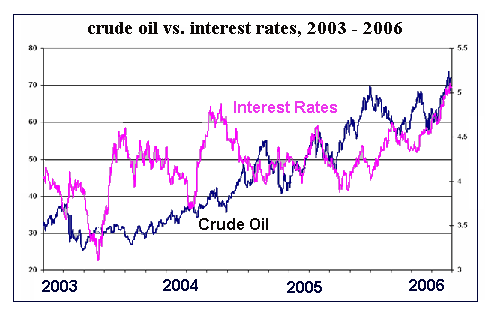
The correlation between the falling dollar and rising oil is certainly striking.
But is it causal? That is, did the price of oil in dollars rise because the dollar was dropping
in relative value? Possibly; but it is also possible that the dollar and the price of oil
are independent of each other. The value of each is set by the global forces of supply and
demand; and as the world was flooded with massive quantities of dollars in the liquidity boom
of 2001-2006, then the value of the dollar declined. As the supply of oil reached a limit
of about 84 million barrels a day, even as demand reached 84-85 MBD, then the price rather
naturally rose.
In another interesting correlation, U.S. interest rates have been rising in
apparent tandem with rising oil prices in dollars. Coincidence again? Perhaps; again,
the cost of money in the U.S. does not seem to have a direct causal link to the cost of oil
in dollars. But there is one correlation: as high oil costs seep into the supply chain
of the entire U.S. economy, that basic material inflation feeds consumer and producer
inflation, which can only be offset by a tightening of money supply and/or borrowing costs.
The trillion-dollar question is: what happens to the price of oil (in dollars) if the dollar
breaks its long-term support level at 80? If the oil exporting nations want to keep
the high value they currently receive, then they will either have to buy the dollar,
driving it back up above 80, or they will have to engineer a corresponding rise in the
price of oil to compensate for the decline in the dollar--
or the oil exporting nations can decide to sell their oil in some other currency and the US
will just have to buy increasingly expensive oil with a declining currency.
Can we expect a 20%
rise in the cost of oil if the dollar falls 20%? Perhaps the question should be
stated, why wouldn't we?
(NOTE: Thank you, UK correspondent, for the corrections and comments which are in italics above.)
August 2, 2006
Phase Transitions, Symmetry and Post-Bubble Declines
Yesterday's invocation of "phase transition" inspired me to apply
this concept to the the real estate market/bubble. The result: this chart.
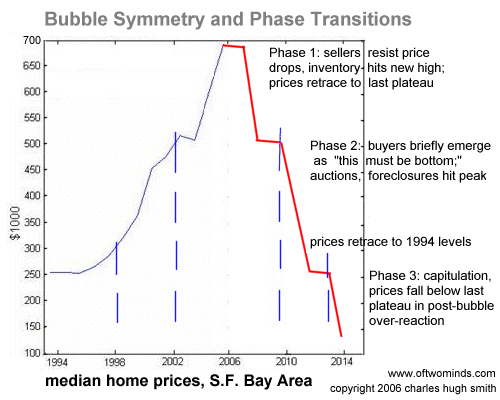
There are differences between the stock market and the housing market, of course--chiefly
that housing is remarkably illiquid compared to stocks. That is, it is quick work
indeed to sell a stock, as there is always a market for any tradable security. Not so with
real estate; as the cliche goes, "you only need one buyer" but that one buyer can seem
awfully scarce in periods of declining prices.
Sellers of real estate are also famously reluctant to drop their price in declining
markets. This reluctance in the face of rising inventories characterizes Phase 1, a
period of modestly declining values from the peak. But when foreclosures begin forcing
sales, an abrupt transition occurs, and home prices will fall rapidly. Once distressed
properties are sold at auction, then an exchange similar to the stock market takes over
pricing: if a property has to be sold, regardless of price, then the price will drop to the
point that it finds a buyer, just as a stock eventually finds a buyer.
Despite the differences between housing and stocks, bubbles share some basic
characteristics which can be described in a Phase 1, 2 and 3 analysis. Phase 2 begins
when prices retrace to the most recent plateau, at which point buyers emerge in the
mistaken belief that "this is the bottom." This trait is clearly visible in a phase
transition analysis of the Nasdaq dot-com era bubble:
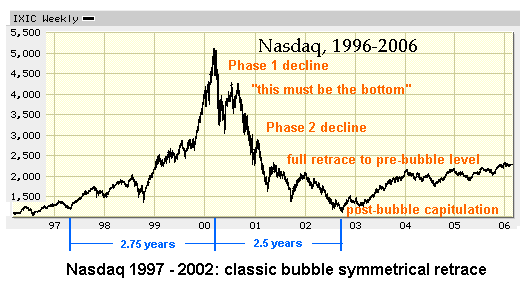
After this burst of euphoria expires under increasing inventory/sales, then Phase 2
is characterized by a massive decline in prices back to the pre-bubble level.
Technical analysts will be familiar with this as the C to D move in a classic A-B-C-D pattern.
Phase 3 is the capitulation stage, when prices over-react to the downside and actually
drop beneath the pre-bubble levels. This pattern is easily seen in the above Nasdaq chart.
There is no reason to believe that the housing market won't suffer a similar capitulation
and retrace to levels once thought impossible.
The other key characteristic of post-bubble declines is the near-symmetry of the
ascent and decline periods. Note that the Nasdaq bubble took about 3 years or so
to reach its zenith, and about 2.5 years to retrace the entire bubble rise plus some.
Again, there is no reason to believe that housing's descent will differ much from the
stock market's post-bubble decline, except that each phase transition pause between
legs of the decline may last longer than equivalent stock market pauses. The reason is,
again, the illiquid nature of the real estate market.
The net result: the housing bubble required about 8 years to reach its zenith. It is
therefore likely to take a similar length of time to reach its final capitulation/over-reaction
price level. No doubt some can quibble about details, but the classic stages of
post-bubble decline make a compelling case that indeed, "this time it is NOT different."
August 1, 2006
Twilight for Exurbia?
I recently received an extremely thought-provoking note from a correspondent which I reprint (with
permission) in its entirety.

"If there is a crash in the housing market many people will be forced to sell or will have
it done for them by the lenders. One can then expect the price to drop and the demand then
to pick up. However home ownership is not without costs - property taxes and maintenance
being the most obvious. Will demand pick up to meet the supply? - maybe not. It is a
reasonable assumption that if there is massive oversupply then there may well not be
buyers for some homes at any price. The source of the oversupply could be in the many
empty properties held by speculators, but also in hard economic times people move in
with family members to save on costs - all of which conspires to reduce demand.
Empty properties soon deteriorate and a reasonable assumption is that many properties will
be abandoned. But, here's the kicker, is the number of abandoned properties likely to be
evenly distributed across every neighbourhood with every street taking its ration of a
couple of empty houses. I think not - these effects tend to concentrate. There will be
always some purchases if the price is right and some neighbourhoods will remain vibrant
and others will become sinks in a classic feedback cycle inhibits or promotes purchases
in the area. Here's a current google maps picture of the remains of a Detroit suburb after
middle class flight - and this happened during a period high housing demand. If you scroll
a mile or two either way you start to see progressively more populated areas.
sample map of Detroit neighborhood.
Sooo... assuming the thesis of asymetrical desolation distribution is correct - what will
be the determining factors in whether a suburb will survive or (as in the image above) die?
It is possible that the future viability of a location will not be predictable a priori -
a bit like chaos theory where small changes can effect improbably large outcomes. For some
years in the future it may be that the value of a property could be almost entirely
dependent on the maintenance level of the surrounding area. This was always the case,
but now the effect may be greatly amplified. In conditions of massive oversupply, it is
possible that once an area gets perceived as being on the downhill slide then the
surrounding houses will rapidly become unsaleable at any price. In physics this is known
as a phase transition (more recently popularized as the Tipping Point) and it happens
rapidly. After a housing price crash, until things settle down, this effect could introduce
extreme price volatility as the market determines which suburbs flip from being viable to
being sinks."
Detroit, of course, was hollowed out by the job losses resulting from the decline of the U.S. auto
industry. The city lost a significant percentage of its population in the period from 1970
to 2000. The question posed by this correspondent is: where might oversupply lead to
outright abandonment of recently built homes?
I would hazard three guesses: exurban areas (far from urban job centers) which lack
nearby employment, new towns in areas of declining demographics, and hastily constructed
homes in hurricane-prone, high-insurance locales.
As an example of scenario #1, we might speculate that new tracts of homes in exurban areas
like Modesto, calif., a long (or even extreme) commute away from job centers, might
remain empty regardless of price. The reason is that massive overbuilding in such areas
far exceeds native population growth; once all the speculators have exited, the thousands of
available homes may well exceed the demand created by new residents supported by local jobs.
Exurban wages tend to be far lower than in urban centers or suburban business parks, which
means that prices for new homes would have to drop appreciably before local wage earners
could afford the new homes.
Additionally, employment typically drops in recessions, which may well translate into a smaller pool of
people willing to endure extreme commutes required to live in exurbia:
Commuting Is a Drag (on the Economy)
more on extreme commutes
In scenario #2, states with declining populations (such as Massachusetts)
may find that simple demographics will leave new subdivisions empty: there aren't
enough new residents of sufficient income to fill the new homes.
In scenario #3, poorly constructed (and thus less desirable) tracts of homes in hurricane-prone
parts of Florida may remain vacant once potential residents discover the high cost of
insuring such homes. The costs of maintaining and insuring such homes may make ownership
financially unattractive.
Threse are just speculations, but they are based on some history. The new subdivisions which
sprang up in Lancaster, Calif., in the last housing boom of the late 80s remained virtual ghost towns
in the early 90s when local aerospace employment shrank. A long commute from Los Angeles
was a disincentive to new residents, as was dropping property values. Why buy in exurbia
when prices are falling and the commute is soul-crushing? Lancaster recovered only as
property values began rising and local employment grew.
The proposition that any empty house can be sold or rented may well turn out to be false.
Residents need jobs, a viable neighborhood and rising property values in order to stake their
claim on distant exurban homes. A dropping price is not an incentive, because it carries
the question implicit in all housing busts/recessions: what's to keep the price from falling
further after I buy?
To view previous entries in July, go to
weblog July 2006.





Please browse this month's entries
and the
archived wEssays listed in the sidebar.
If nothing here strikes
your fancy, skim through my recently published articles
(generally in the San Francisco Chronicle) and my archives back to 1995.
I would be honored if you link any essay to your website,
print a copy for your own
use or add my RSS or Atom feed.
And of course I appreciate your recommendations of this weblog and your comments:
csmith@oftwominds.com.





wEssay noun, combination of 'web' and 'essay,' denoting a short online essay
which exploits the hyperlinks, interfaces and interactive capabilities of the World Wide
Web; coined by Charles Hugh Smith on May 1, 2005, in Berkeley California.
Aphorisms I live by:
"May a fair road always be open to you." (CHS, April 2, 2006)
The way of the Tao is reversal." (Lao Tzu)
"Chance favours the prepared mind.” (Louis Pasteur)
All content and images copyright © 2006 Charles Hugh Smith, All rights reserved in all media,
unless otherwise credited or noted.
|
 |
Subscribe via RSS:
search my site:
|





 1. Size matters. Wal-Mart is by far the world's largest retailer. Though this
chart is a bit dated (2005 sales at Wal-Mart exceeded $285 billion, and 2006 sales are on
track to hit over $300 billion), the relative weight of Wal-Mart compared to its global
competitors hasn't changed. It is the proverbial 800-pound gorilla. Its policies can
literally move the world.
1. Size matters. Wal-Mart is by far the world's largest retailer. Though this
chart is a bit dated (2005 sales at Wal-Mart exceeded $285 billion, and 2006 sales are on
track to hit over $300 billion), the relative weight of Wal-Mart compared to its global
competitors hasn't changed. It is the proverbial 800-pound gorilla. Its policies can
literally move the world.
 If one retailer pays a decent wage and provides its employees with some medical insurance
and 401K-type pension, while another pays lower wages and few benefits, because it knows
the government will provide those for its employees if it doesn't, then who wins in the
long run? The competitor (Wal-Mart) who is basically using the government to pay some of its
employee benefits (medical and retirement).
If one retailer pays a decent wage and provides its employees with some medical insurance
and 401K-type pension, while another pays lower wages and few benefits, because it knows
the government will provide those for its employees if it doesn't, then who wins in the
long run? The competitor (Wal-Mart) who is basically using the government to pay some of its
employee benefits (medical and retirement).
 Ah, but you can't have it both ways. Either way the Fed goes, they will get
the same result--recession. Wait a minute--how is that possible? Read on.
Ah, but you can't have it both ways. Either way the Fed goes, they will get
the same result--recession. Wait a minute--how is that possible? Read on.
 What could trigger such a devaluation? An abandonment of the dollar by foreign investors
who suddenly realize even their massive buying can no longer keep the dollar high. Or
perhaps Venezuela, Iran and Russia announce that they're pricing their oil in euros. The
final straw is unknown, but the risks, at least to people like Buffett, appear to be growing.
(Correspondent Wayne D. has posted Buffett's comments on
his board,
Warren Buffett on the dollar.)
What could trigger such a devaluation? An abandonment of the dollar by foreign investors
who suddenly realize even their massive buying can no longer keep the dollar high. Or
perhaps Venezuela, Iran and Russia announce that they're pricing their oil in euros. The
final straw is unknown, but the risks, at least to people like Buffett, appear to be growing.
(Correspondent Wayne D. has posted Buffett's comments on
his board,
Warren Buffett on the dollar.)
 For instance, since we import so much, then a big jump in import prices would feed inflation:
we're paying more for the same goods. Except from China, of course, which pegs the yuan
at 8 to the dollar. A dollar devaluation would be a boon to China, as it would discount
their goods in Europe and Asia while leaving exports to the U.S. untouched. In that sense,
a dollar devaluation would be favorable to China, and not something they would fear. Perhaps
they would even welcome it as a support to their exports and a "tax" on imports from Japan
and Europe.
For instance, since we import so much, then a big jump in import prices would feed inflation:
we're paying more for the same goods. Except from China, of course, which pegs the yuan
at 8 to the dollar. A dollar devaluation would be a boon to China, as it would discount
their goods in Europe and Asia while leaving exports to the U.S. untouched. In that sense,
a dollar devaluation would be favorable to China, and not something they would fear. Perhaps
they would even welcome it as a support to their exports and a "tax" on imports from Japan
and Europe.
 But in another way, Japan and Europe would
certainly not welcome such a devaluation, as it would impose an instant 37% "tax" on their
exports to the U.S. Which is more important--cheaper oil or exports to the U.S.? That
is yet another sticky wicket.
But in another way, Japan and Europe would
certainly not welcome such a devaluation, as it would impose an instant 37% "tax" on their
exports to the U.S. Which is more important--cheaper oil or exports to the U.S.? That
is yet another sticky wicket.
 I am continually astonished (and of course gratified) by the high bandwidth, knowledge
and experience of this humble site's readers. You, the readers, provide information
to your fellow readers which is often unavailable elsewhere.
I am continually astonished (and of course gratified) by the high bandwidth, knowledge
and experience of this humble site's readers. You, the readers, provide information
to your fellow readers which is often unavailable elsewhere.
 Herewith are two stories of the Great Housing Bubble Pop, which we are
witnessing in a weird, slow-motion implosion sort of way. The first story comes from a Comcast
cable installer, who works as a subcontractor for Comcast.
Herewith are two stories of the Great Housing Bubble Pop, which we are
witnessing in a weird, slow-motion implosion sort of way. The first story comes from a Comcast
cable installer, who works as a subcontractor for Comcast.

 Looking into my cracked crystal ball, I caught a glimpse of a certain Joe E. Blow,
Real Estate Investment Management, and was able to discern how his marketing campaign changed in
the future. I might have missed a few details in the blurry fog within the crystal,
but this is what I saw:
Looking into my cracked crystal ball, I caught a glimpse of a certain Joe E. Blow,
Real Estate Investment Management, and was able to discern how his marketing campaign changed in
the future. I might have missed a few details in the blurry fog within the crystal,
but this is what I saw:









